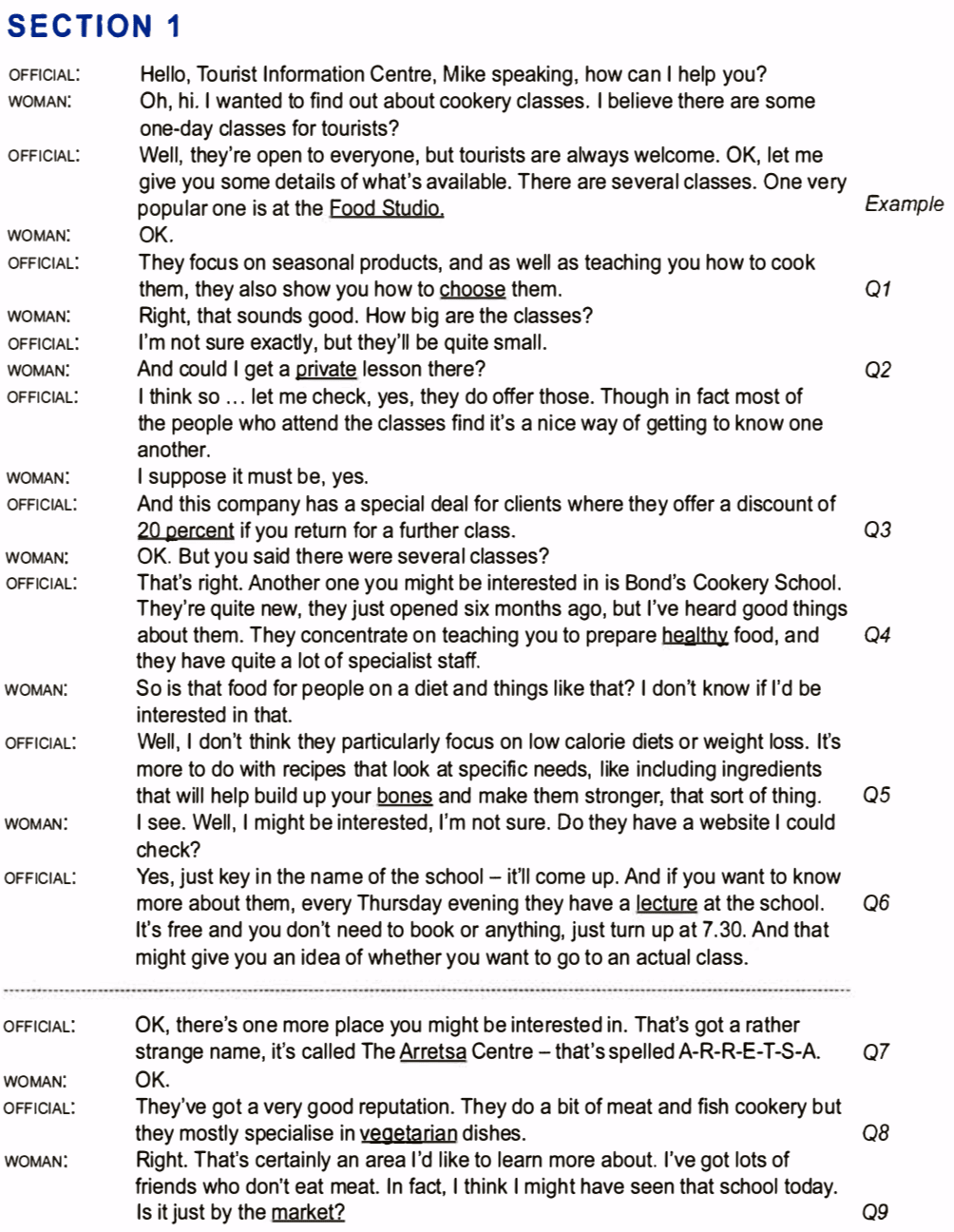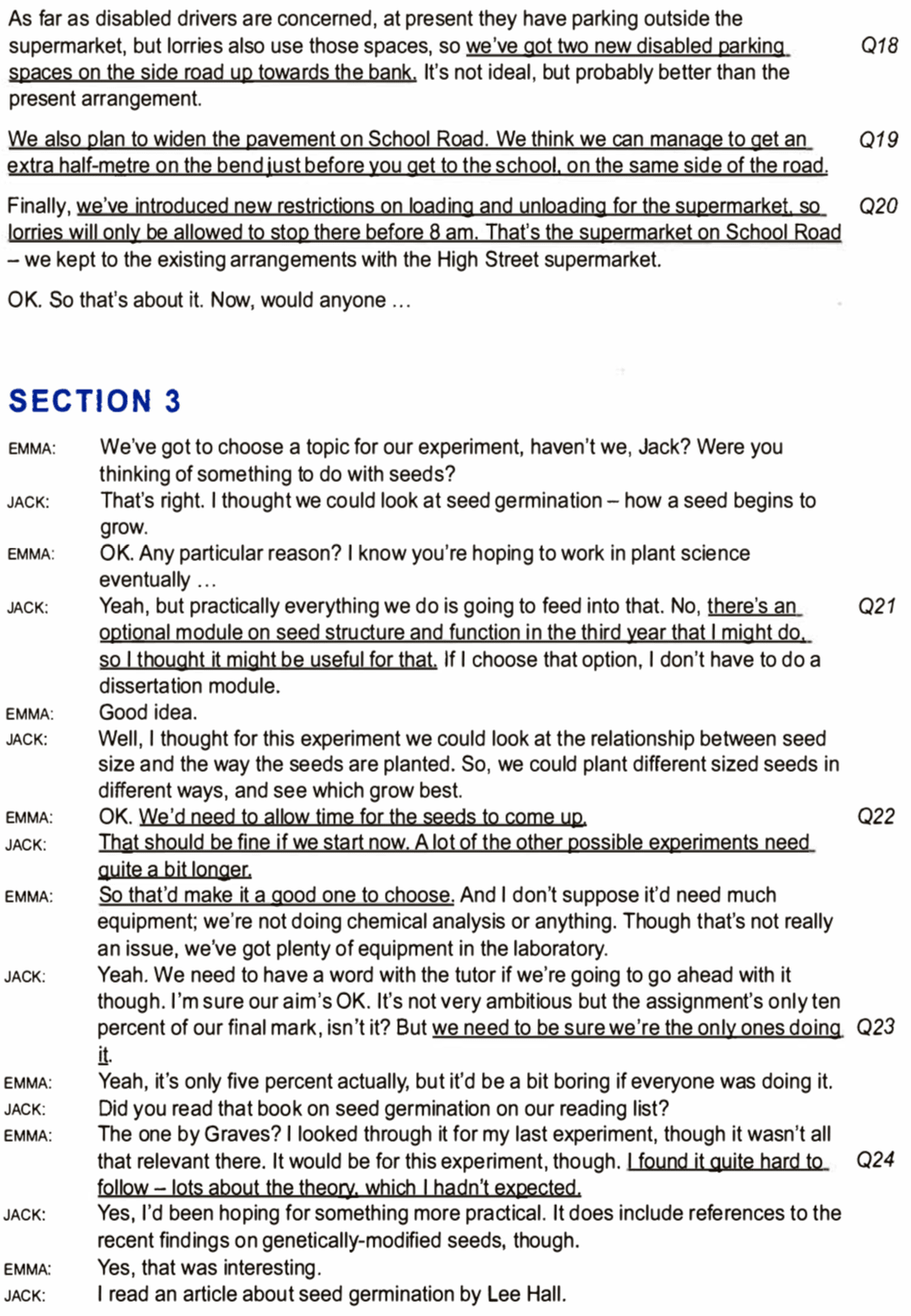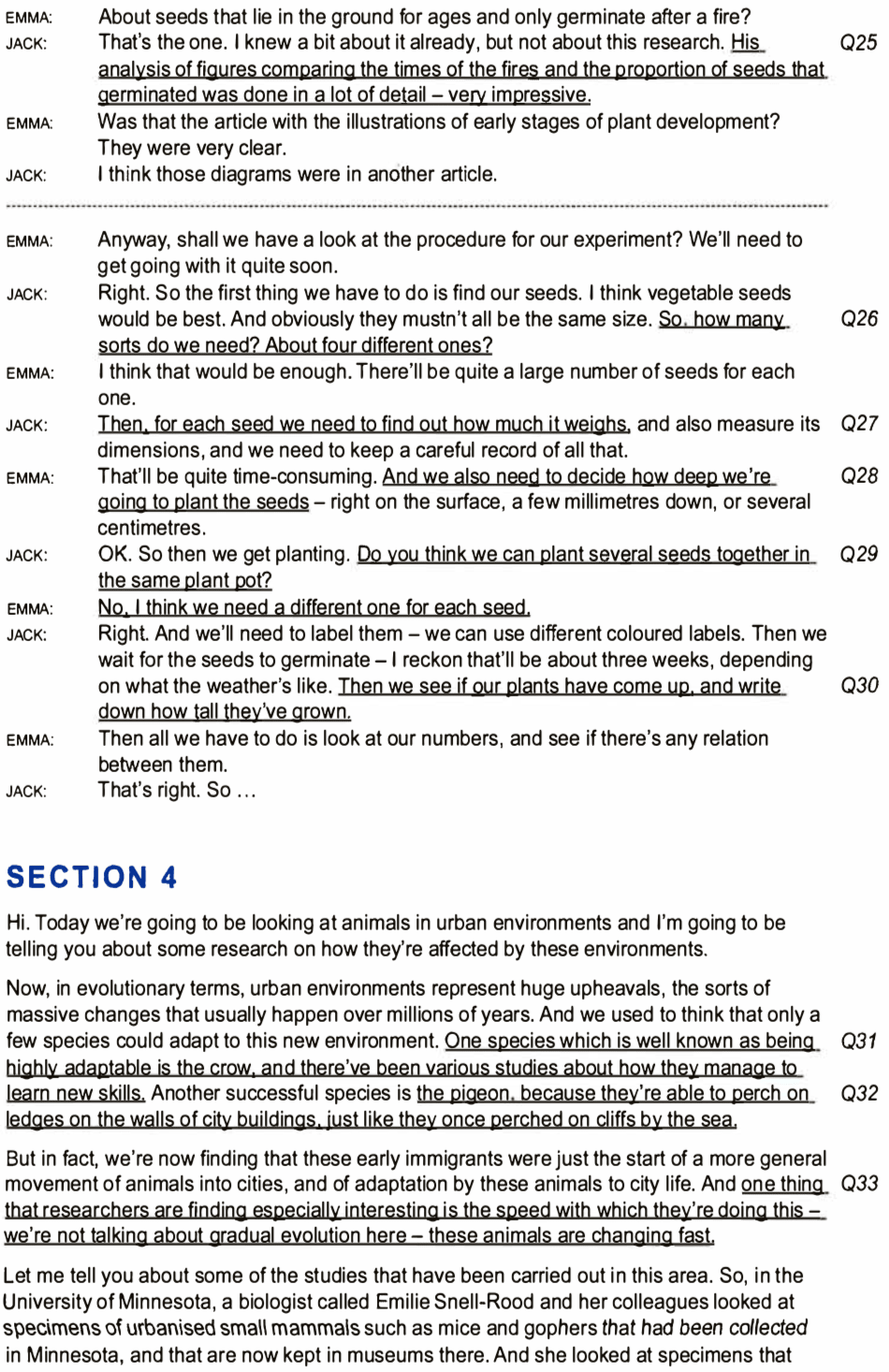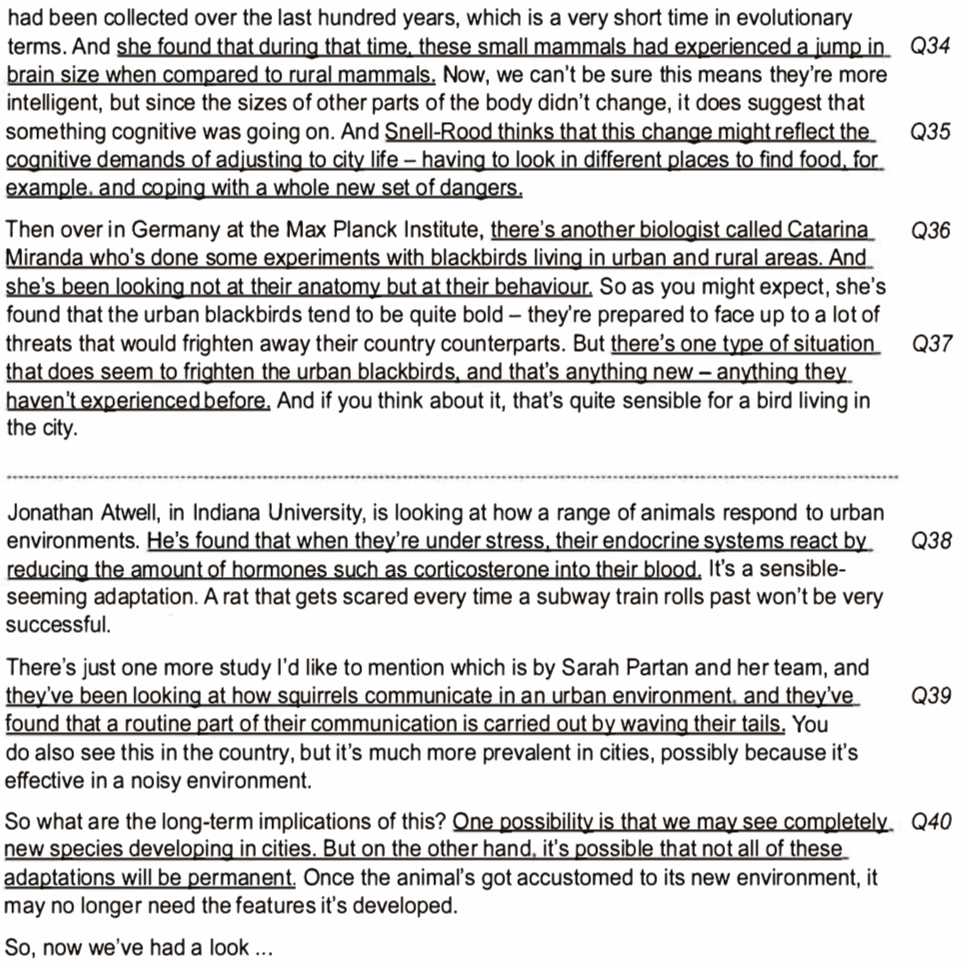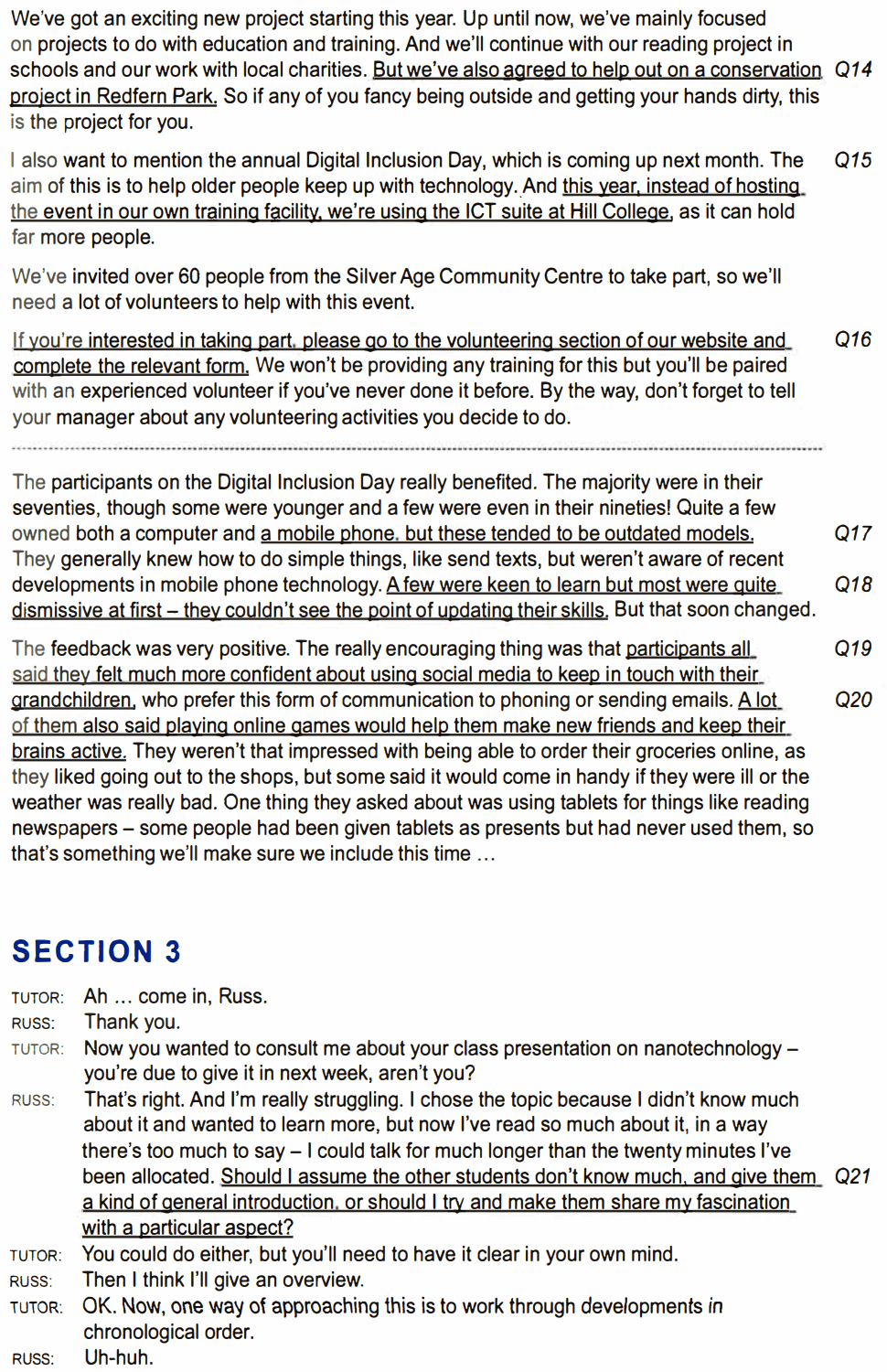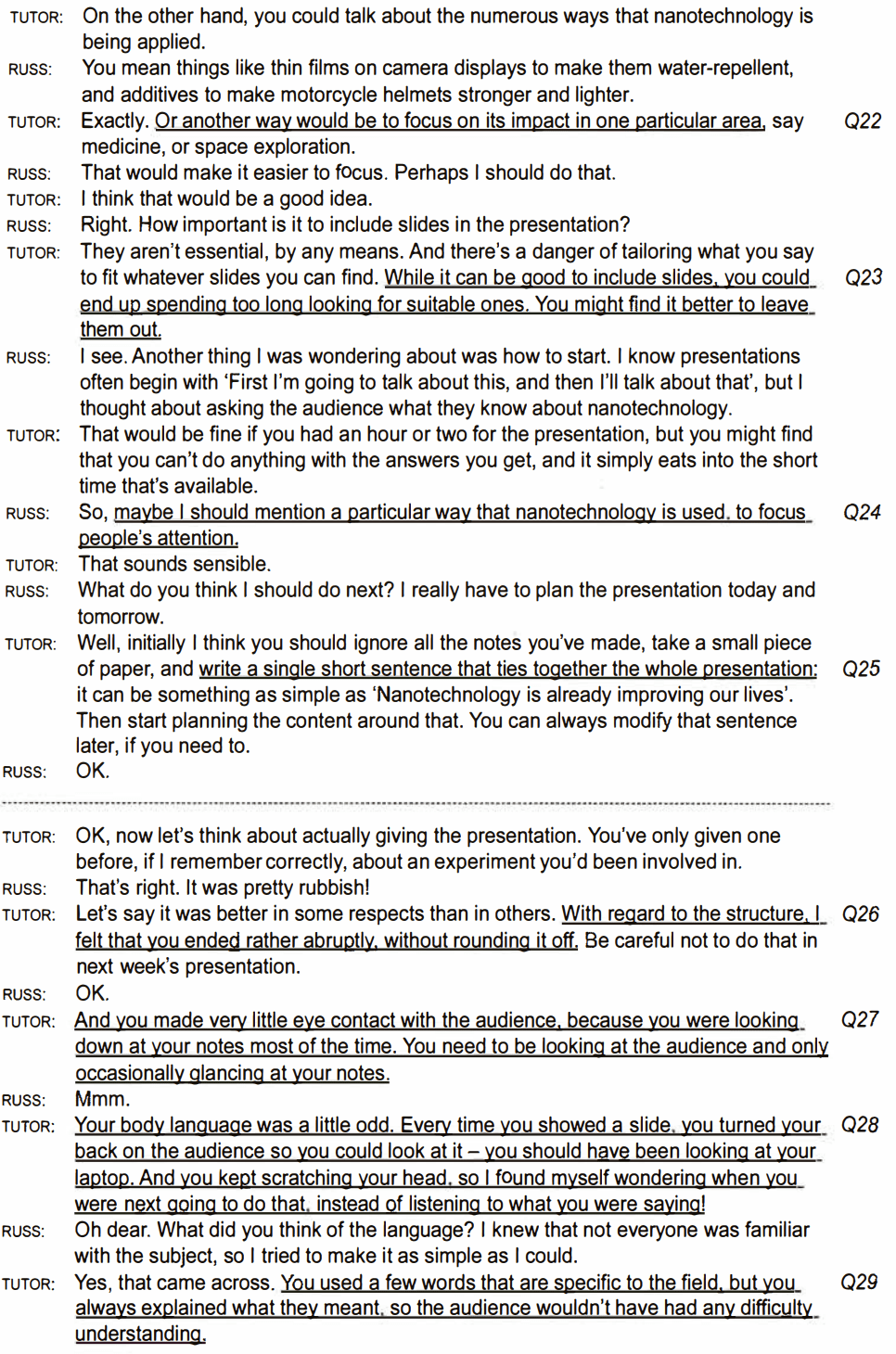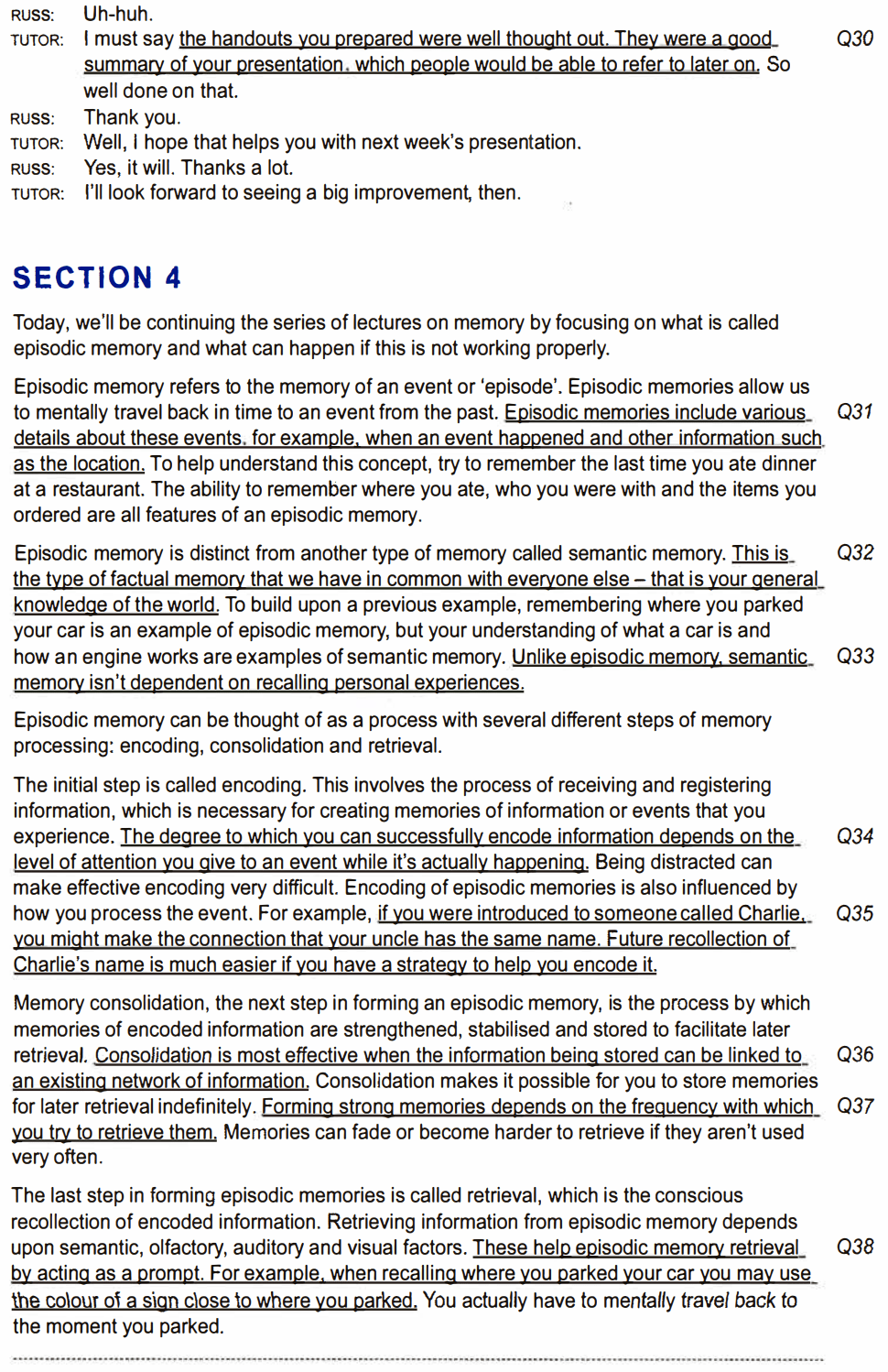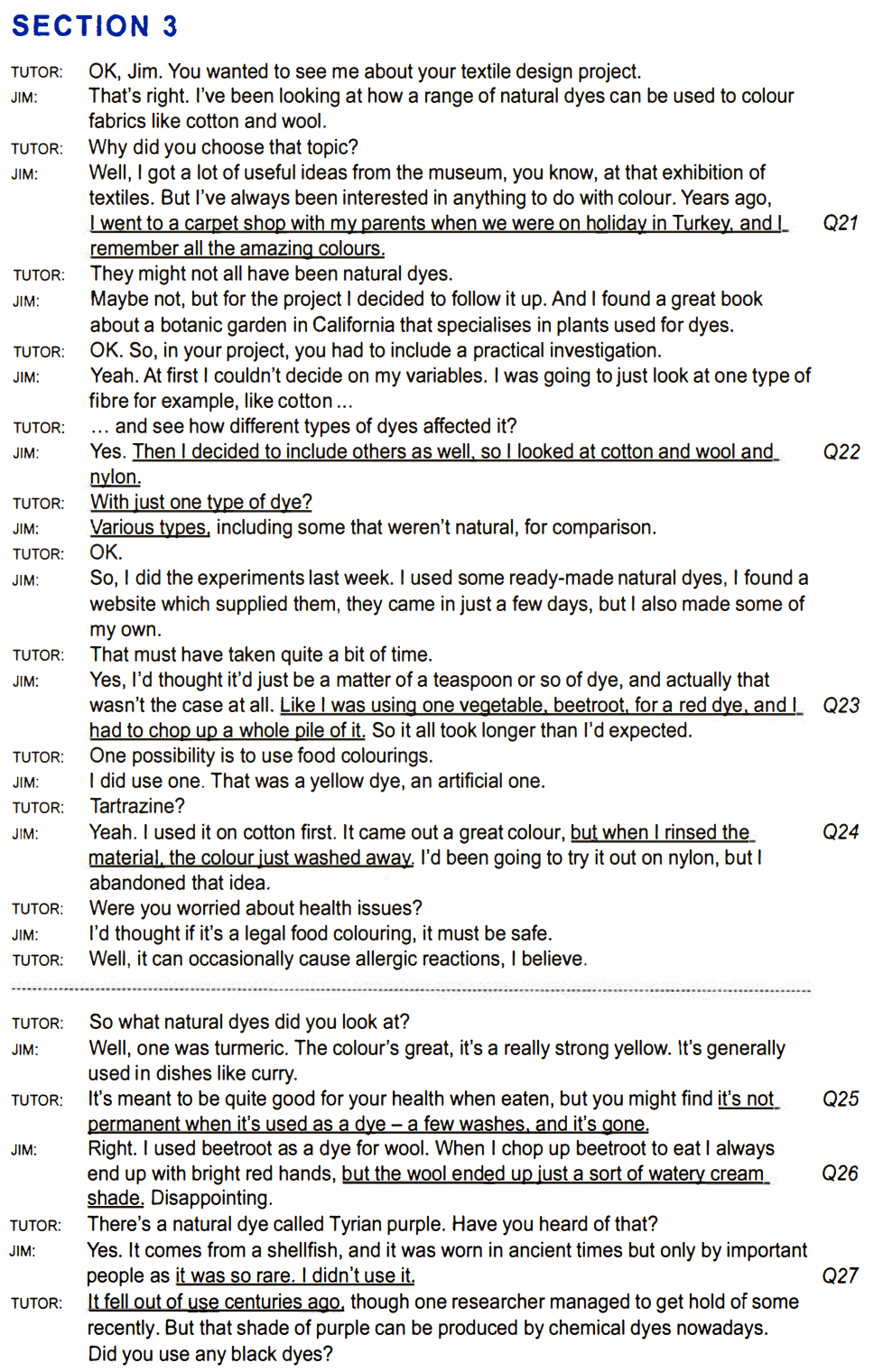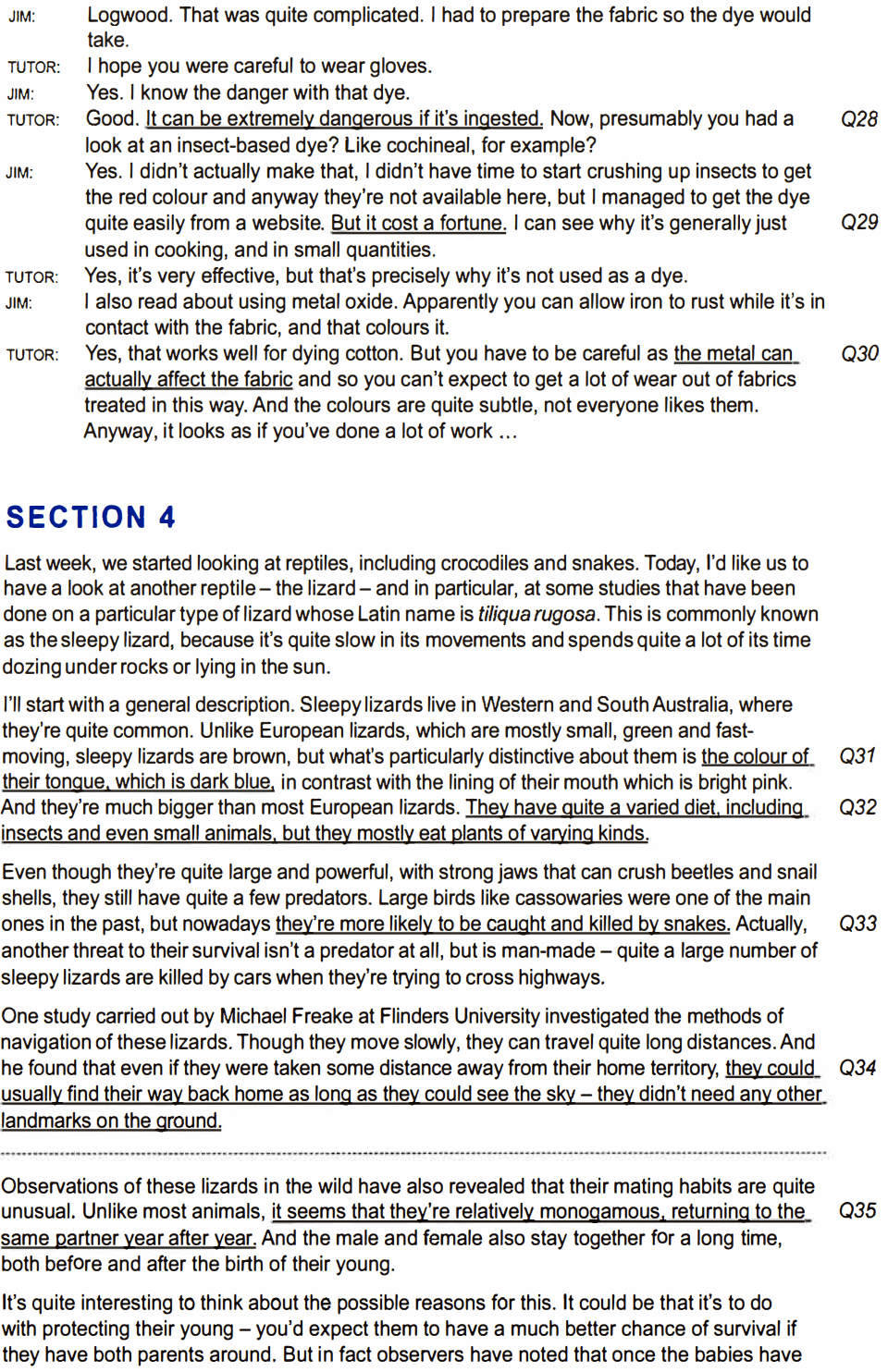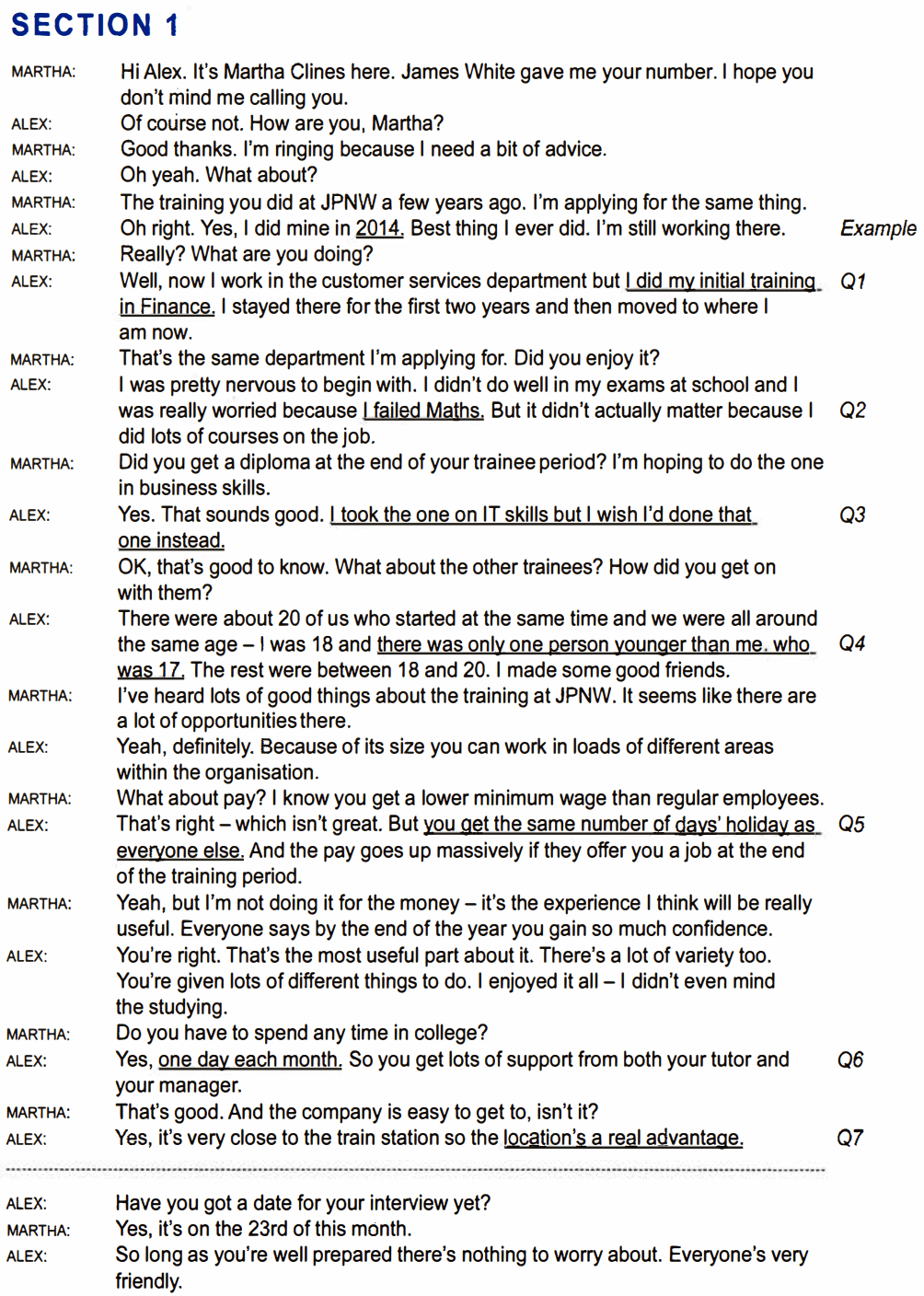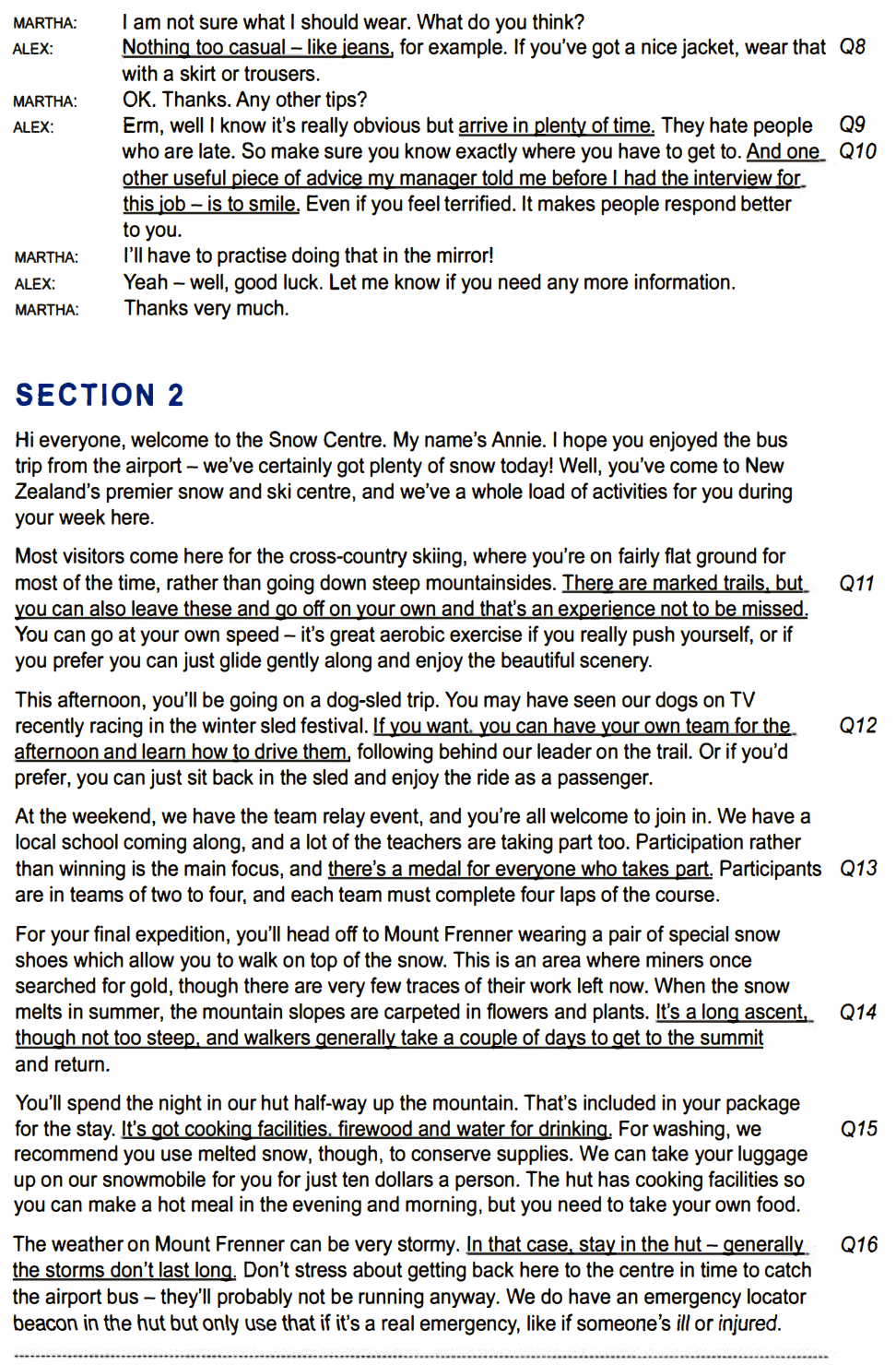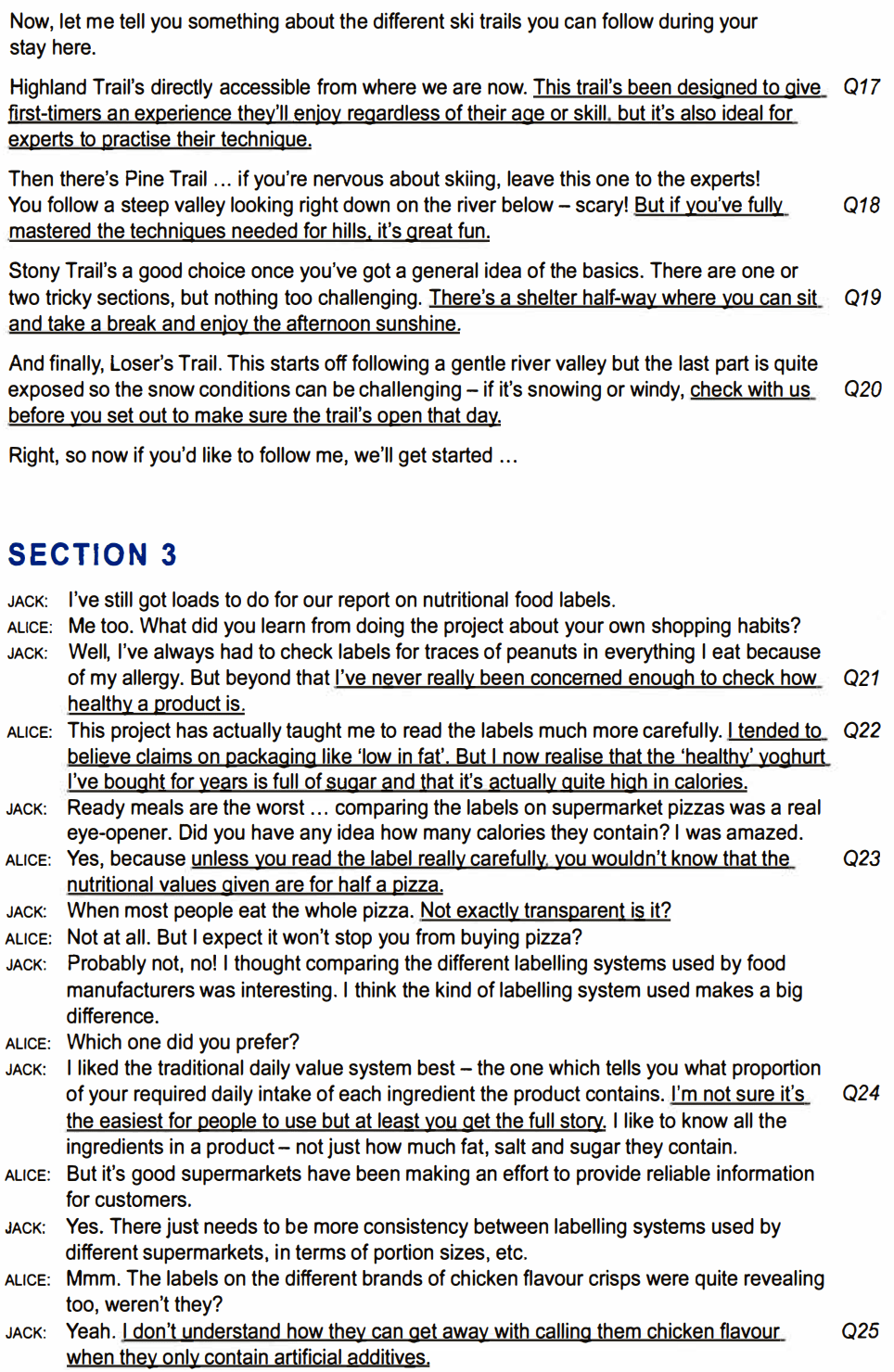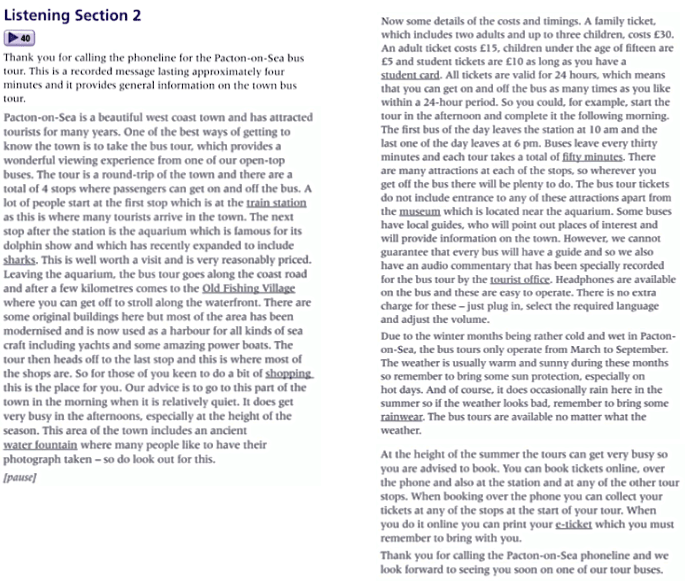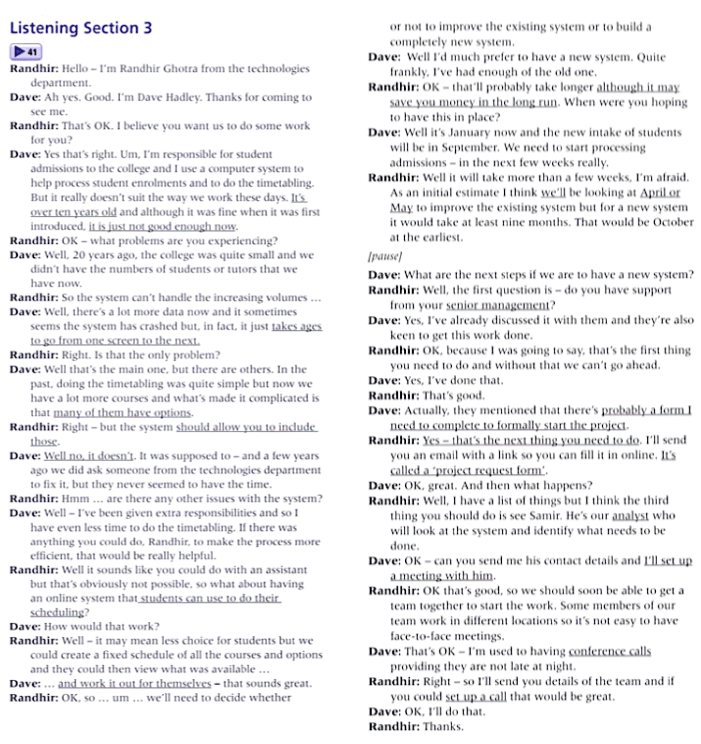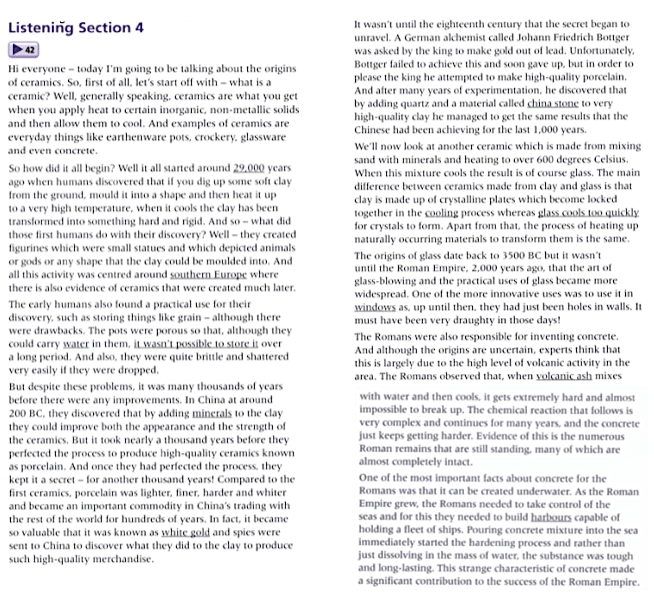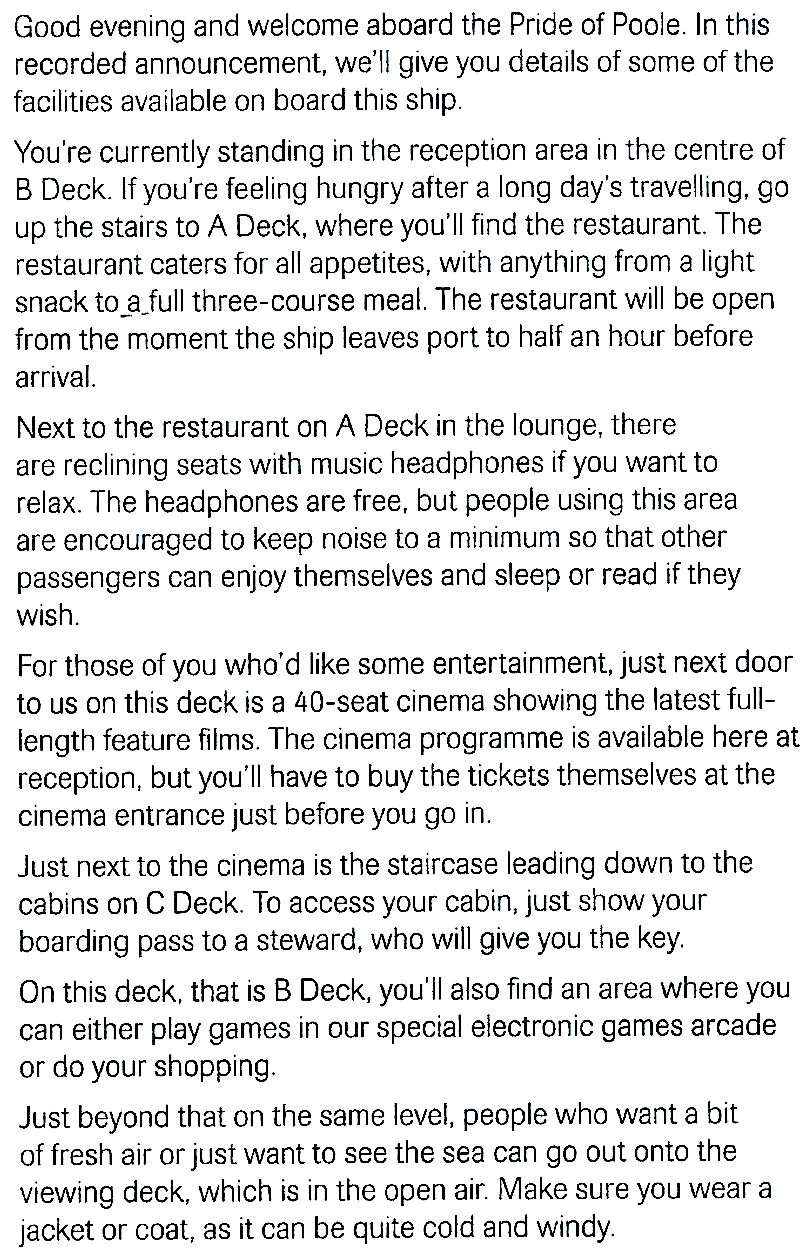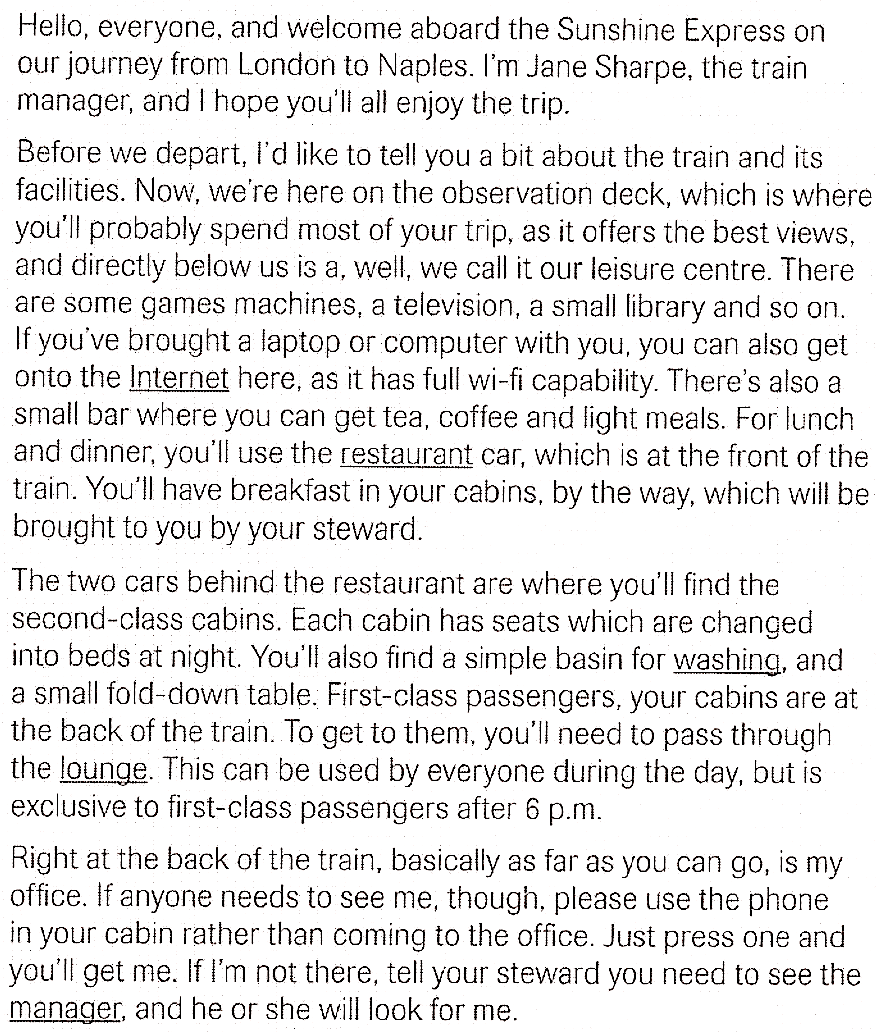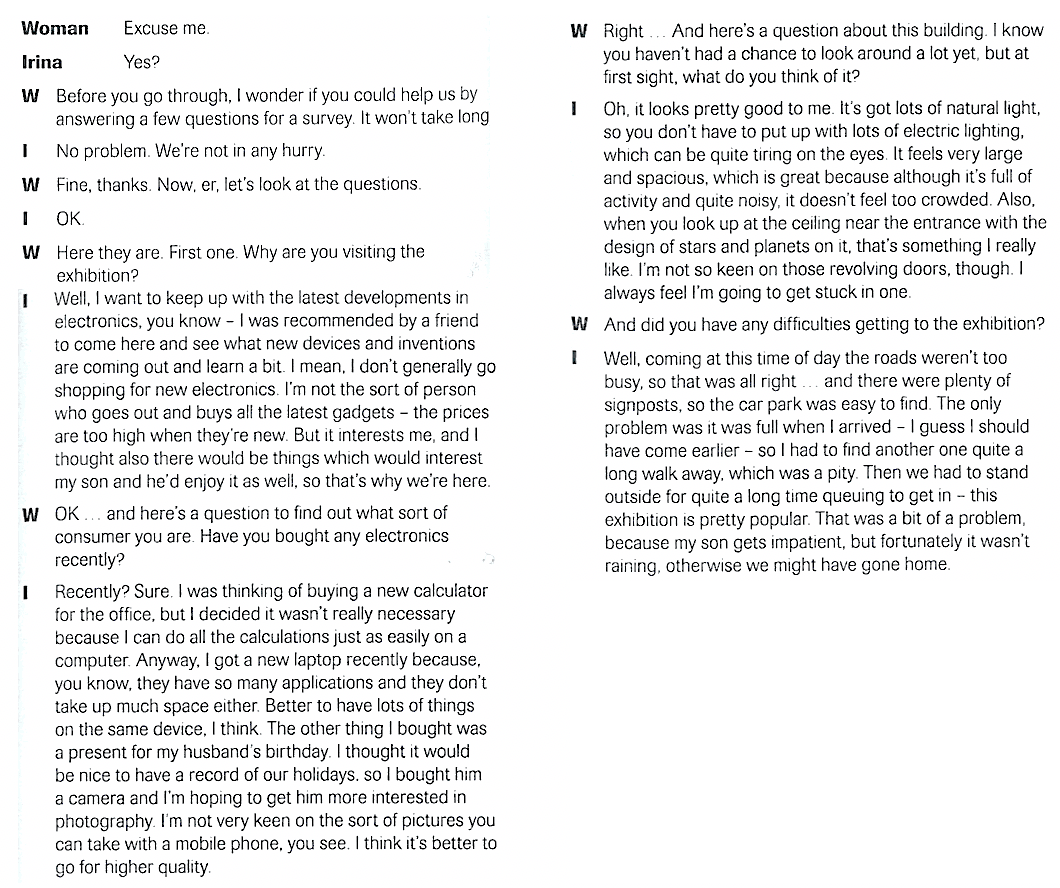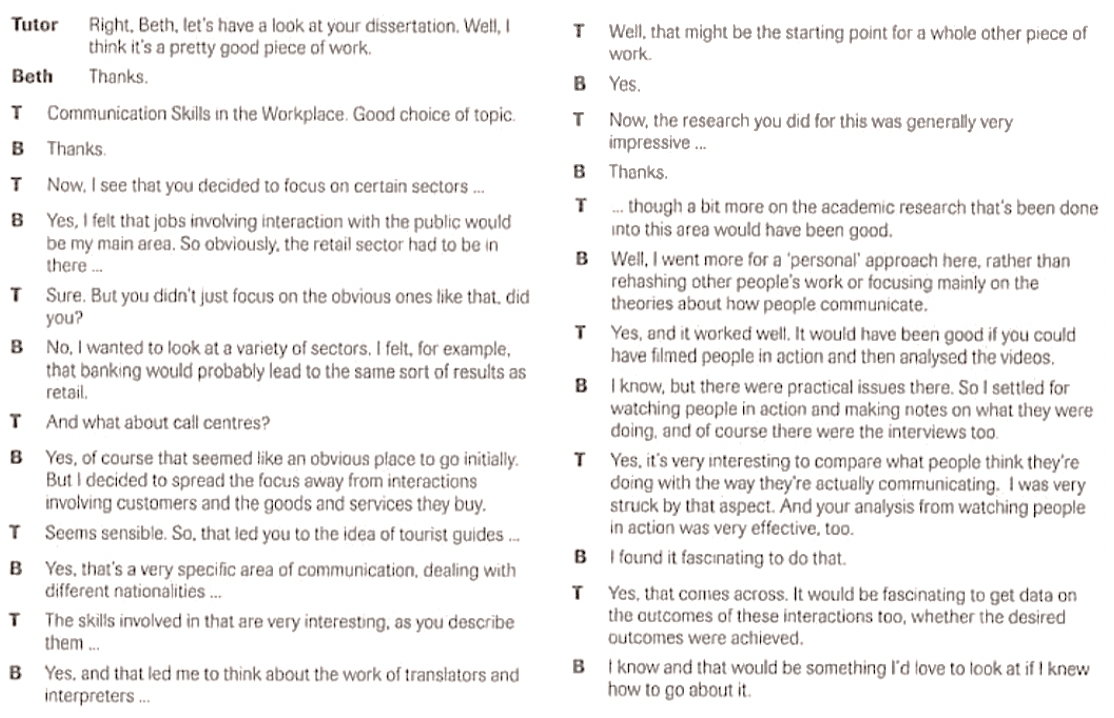Diagram 4C

Only used for admin purposes

If your lecturers are unavailable, you can always come and see me in my office. I’m available on Wednesday and Thursday mornings and on Friday afternoons Q37 Outside these hours, perhaps you could ring the secretary and make an appointment. Now you’ll note that all of the subjects which you undertake in the first year are composed of lectures and tutorials. A lecture is about an hour long and a tutorial usually runs for about two hours. A lecture is rather like what I am doing now where one person will talk to all of you together on a subject. We do ask you to try to attend the lectures. A tutorial is perhaps where most of the learning occurs at a university. You will be divided into groups of between 12 and 15 students and each week one of you will have to present a piece of work to the group as a whole and then the group will discuss what you’ve said. It’s this discussion, this exchange of ideas, which Q38 really constitutes the basis of university learning, in my view. Listening to lectures in many ways is just giving you information that you could access for yourself in
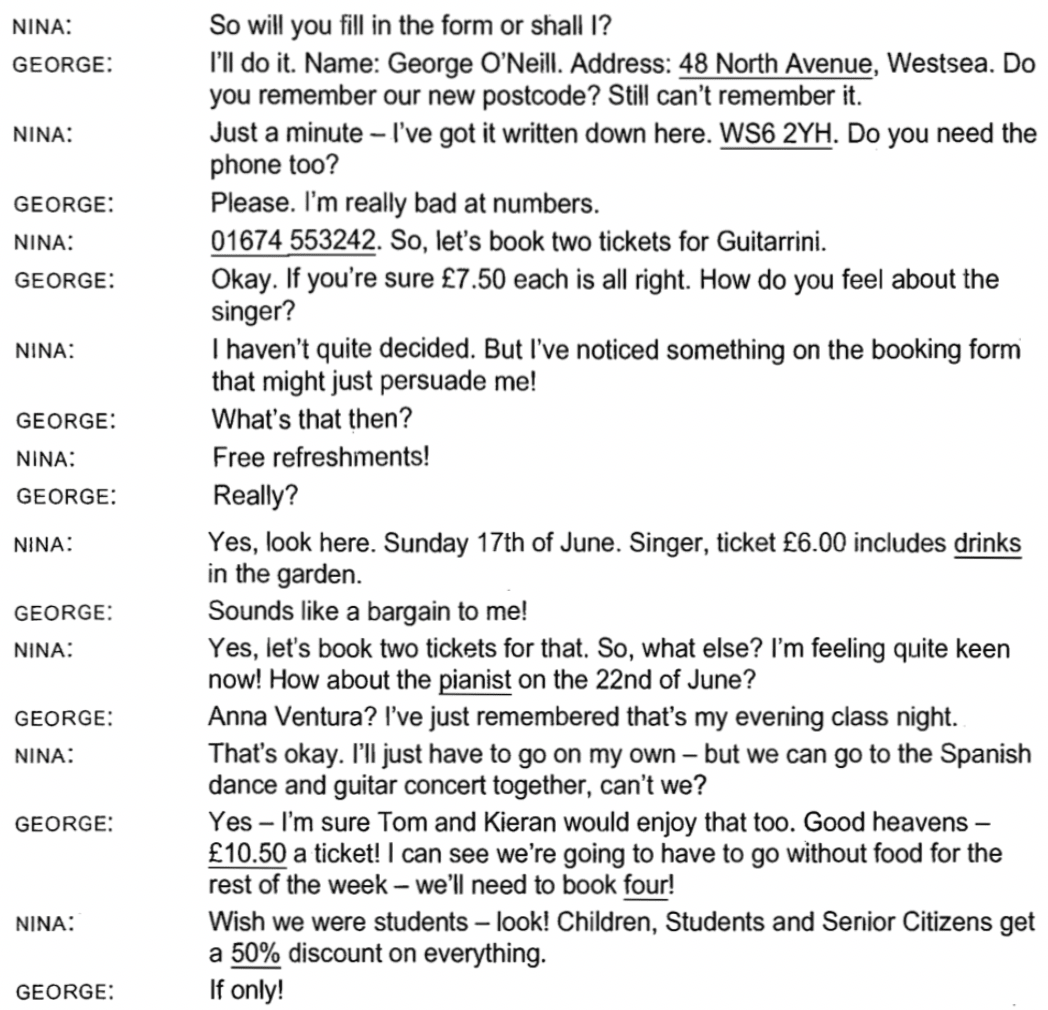



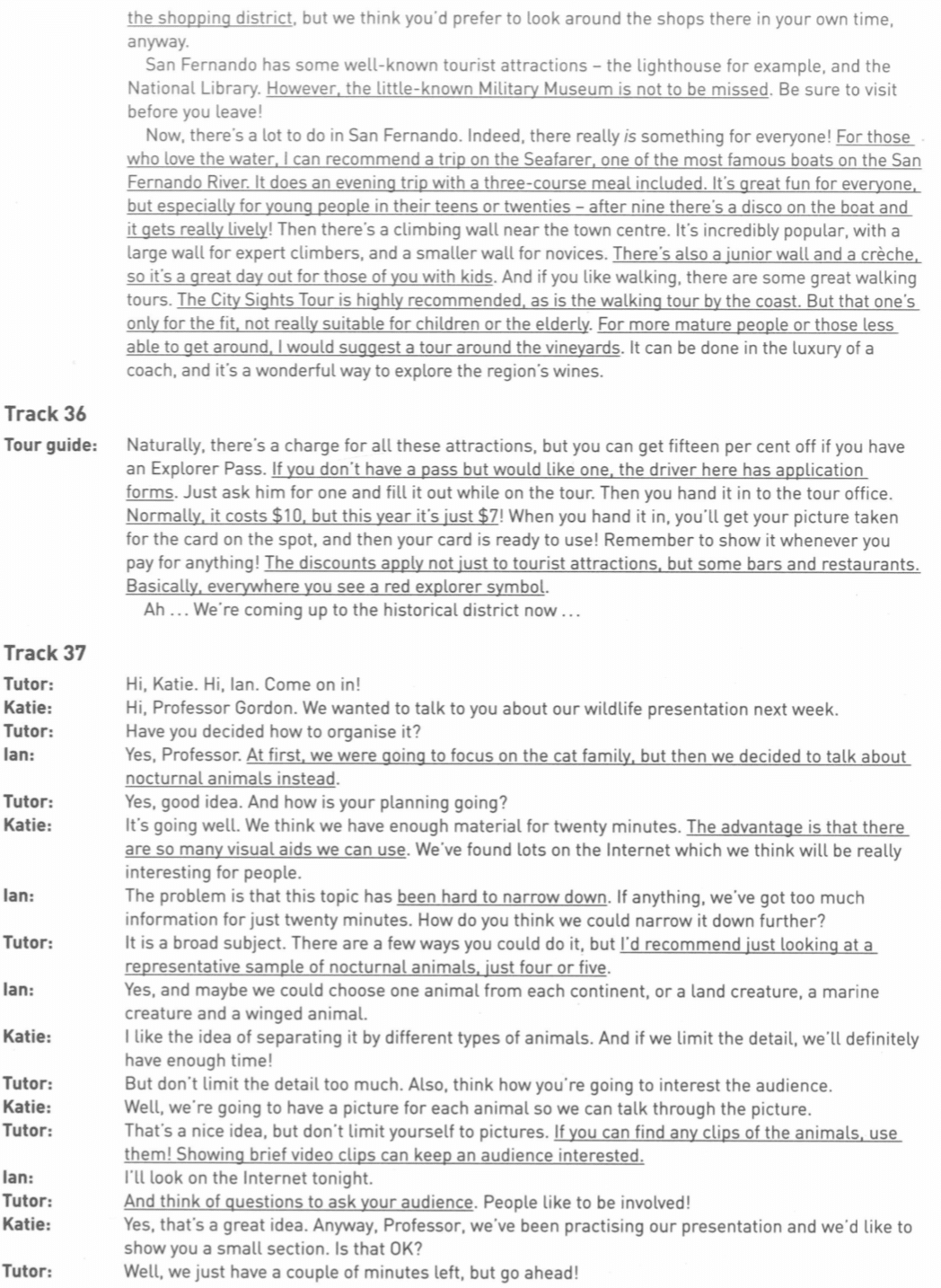

OFFICER: Good morning. What can I do for you?
LOUISE: I want to report a theft. I had some things stolen out of my bag yesterday.
OFFICER: I’m sorry to hear that. Right, so I’ll need to take a few details. Can I start with your name?
LOUISE: Louise Taylor. (Example)
OFFICER: OK, thank you. And are you resident in the UK?
LOUISE: No, I’m actually Canadian (Q1). Though my mother was British.
OFFICER: And your date of birth?
LOUISE: December 14th, 1977.
OFFICER: So you’re just visiting this country?
LOUISE: That’s right. I come over most summers on business. I’m an interior designer and I come over to buy old furniture (Q2), antiques you know. There are some really lovely things around here, but you need to get out to the small towns. I’ve had a really good trip this year, until this happened.
OFFICER: OK. So you’ve been here quite a while?
LOUISE: Yes, I’m here for two months. I go back next week.
OFFICER: So may I ask where you’re staying now?
LOUISE: Well at present I’ve got a place at Park (Q3) Apartments, that’s on King Street. I was staying at the Riverside Apartments on the same street, but the apartment there was only available for six weeks so I had to find another one.
OFFICER: OK. And the apartment number?
LOUISE: Fifteen.
LOUISE: Right.
…………………………………………..
OFFICER: Now, I need to take some details of the theft. So you said you had some things stolen out of your bag?
LOUISE: That’s right.
OFFICER: And were you actually carrying the bag when the theft took place?
LOUISE: Yes, I really can’t understand it. I had my backpack on. And I went into a supermarket to buy a few things and when I opened it up my wallet wasn’t there.
OFFICER: And what did your wallet have in it?
LOUISE: Well, fortunately I don’t keep my credit cards in that wallet – I keep them with my passport in an inside compartment in my backpack. But there was quite a bit of cash there … about £250 (Q4) sterling, I should think. I withdrew £300 from my account yesterday, but I did a bit of shopping, so I must have already spent about £50 of that.
OFFICER: OK.
LOUISE: At first I thought, oh I must have left the wallet back in the apartment, but then I realised my phone (Q5) had gone as well. It was only a week old, and that’s when I realised I’d been robbed. Anyway at least they didn’t take the keys to my rental car.
OFFICER: Yes. So you say the theft occurred yesterday?
LOUISE: Yes.
OFFICER: So that was September the tenth (Q6). And do you have any idea at all of where or when the things might possibly have been stolen?
LOUISE: Well at first I couldn’t believe it because the bag had been on my back ever since I left the apartment after lunch. It’s just a small backpack, but I generally use it when I’m travelling because it seems safer than a handbag. Anyway, I met up with a friend, and we spent a couple of hours in the museum (Q7). But I do remember that as we were leaving there, at about 4 o’clock, a group of young boys ran up to us, and they were really crowding round us, and they were asking us that time (Q8) it was, then all of a sudden they ran off.
OFFICER: Can you remember anything about them?
LOUISE: The one who did most of the talking was wearing a T-shirt with a picture of something … let’s see … a tiger.
OFFICER: Right. Any idea of how old he might have been?
LOUISE: Around twelve years old?
OFFICER: And can you remember anything else about his appearance?
LOUISE: Not much. He was quite thin …
OFFICER: Colour of hair?
LOUISE: I do remember that – he was blond (Q9). All the others were dark-haired.
OFFICER: And any details of the others?
LOUISE: Not really. They came and went so quickly.
OFFICER: Right. So what I’m going to do now is give you a crime reference number so you can contact your insurance company. So this is ten digits: 87954 82361 (Q10).
LOUISE: Thank you. So should I …
Good morning everyone. My name’s Janet Parker and I’m the human resources manager. We’re very happy to welcome you to your new apprenticeship. I hope that the next six months will be a positive and enjoyable experience for you.
I’d like to start with some general advice about being an apprentice. Most of you have very little or no experience of working for a big organisation and the first week or so may be quite challenging. There will be a lot of new information to take in but don’t worry too much about trying to remember everything. The important thing is to (Q11) check with someone if you’re not sure what to do – you’ll find your supervisor is very approachable and won’t mind explaining things or helping you out. You’re here to learn so make the most of that opportunity. You’ll be spending time in different departments during your first week so make an effort to (Q12) talk to as many people as possible about their work – you’ll make some new friends and find out lots of useful information.
As well as having a supervisor, you’ll each be assigned a mentor. This person will be someone who’s recently completed an apprenticeship and you’ll meet with them on a weekly basis. Their role is to provide help and support throughout your apprenticeship. Of course, this doesn’t mean they’ll actually do any of your work for you – instead they’ll be asking you about (Q13) what goals you’ve achieved so far, as well as helping you to identify any areas for improvement. You can also (Q14) discuss your more long-term ambitions with them as well.
————————–
Now I just want to run through a few company policies for our apprenticeship scheme with you… Most importantly, the internet. As part of your job you’ll be doing some research online so obviously you’ll have unlimited access for that but please (Q15) don’t use it for personal use – you’ll have your own phones for that.
Some of you have already asked me about flexible working. After your probationary three-month period – some of you will be eligible for this – but (Q16) it will depend on which department you’re in and what your personal circumstances are. So please don’t assume you’ll automatically be permitted to do this.
I want to make sure there’s no confusion about our holiday policy. Apart from any statutory public holidays (Q17) we ask that you don’t book any holidays until after your six-month apprenticeship has finished. Time off should only be taken if you are unwell. Please speak to your supervisor if this is going to be a problem.
You’ll be expected to work a 40-hour week but there may be opportunities to do overtime during busy periods. Although you’re not required to do this, (Q18) it can be a valuable experience – so we advise you to take it up if possible. Obviously, we understand that people do have commitments outside work, so don’t worry if there are times when you are unavailable.
As you know, we don’t have a formal dress code here – you may wear casual clothes as long as they’re practical – and the only restriction for shoes we have is on high heels for health and safety reasons. (Q19) Comfortable shoes like trainers are preferable.
There’s a heavily subsidised canteen on site where you can get hot meals or salads cheaply. Snacks and drinks are also provided – so (Q20) we’ve decided to introduce a no packed lunch policy. This is partly to encourage healthy eating at work and partly to stop people from eating at their workstation, which is unhygienic.
OK moving on to …
TUTOR: OK, so what I’d like you to do now is to talk to your partner about your presentations on urban planning. You should have done most of the reading now, so I’d like you to share your ideas, and talk about the structure of your presentation and what you need to do next.
CARLA: OK Rob. I’m glad we chose quite a specific topic – cities built next to the sea. It made it much easier to find relevant information.
ROB: Yeah. And cities are growing so quickly – I mean, we know that more than half the world’s population lives in cities now.
CARLA: Yeah, though that’s all cities, not just ones on the coast. But (Q21) most of the biggest cities are actually built by the sea. I’d not realised that before.
ROB: Nor me. And what’s more, a lot of them are built at places where rivers come out into the sea. But apparently this can be a problem.
CARLA: Why?
ROB: Well, as the city expands, agriculture and industry tend to spread further inland along the rivers, and so agriculture moves even further inland up the river. That’s not necessarily a problem, except (Q22) it means more and more pollutants are discharged into the rivers.
CARLA: So these are brought downstream to the cities?
ROB: Right. Hmm. Did you read that article about Miami, on the east coast of the USA?
CARLA: No.
ROB: Well, apparently back in the 1950s they build channels to drain away the water in case of flooding.
CARLA: Sounds sensible.
ROB: Yeah, they spent quite a lot of money on them. (Q23) But what they didn’t take into account was global warming. So they built the drainage channels too close to sea level, and now sea levels are rising, they’re more or less useless. If there’s a lot of rain, the water can’t run away, there’s nowhere for it to go. The whole design was faulty.
CARLA: So what are the authorities doing about it now?
ROB: I don’t know. I did read that they’re aiming to stop disposing of waste into the ocean over the next ten years.
CARLA: But that won’t help with flood prevention now, will it?
ROB: No. Really (Q24) they just need to find the money for something to replace the drainage channels, in order to protect against flooding now. But in the long term they need to consider the whole ecosystem.
CARLA: Right. Really, though, coastal cities can’t deal with their problems on their own, can they? I mean, they’ve got to start acting together at an international level instead of just doing their own thing.
ROB: Absolutely. The thing is, everyone knows what the problems are and environmentalists have a pretty good idea of what we should be doing about them, so (Q25) they should be able to work together to some extent. But it’s going to be a long time before countries come to a decision on what principles they’re prepared to abide by.
CARLA: Yes, if they ever do.
——————————
CARLA: So I think we’ve probably got enough for our presentation. It’s only fifteen minutes.
ROB: OK. So I suppose we’ll begin with some general historical background about why coastal cities were established. But (Q26) we don’t want to spend too long on that, the other students will already know a bit about it. It’s all to do with communications and so on.
CARLA: Yes. We should mention some geographical factors, things like wetlands and river estuaries and coastal erosion and so on. We could have some maps of different cities with these features marked.
ROB: On a handout you mean? Or (Q27) some slides everyone can see?
CARLA: Yeah, that’d be better.
ROB: It’d be good to go into past mistakes in a bit more detail. Did you read that case study of the problems there were in New Orleans with flooding a few years ago?
CARLA: Yes, (Q28) We could use that as the basis for that part of the talk. I don’t think the other students will have read it, but they’ll remember hearing about the flooding at the time.
ROB: OK. So that’s probably enough background.
CARLA: So then we’ll go on to talk about what action’s being taken to deal with the problems of coastal cities.
ROB: OK. What else do we need to talk about? Maybe something on future risks, looking more at the long term, if populations continue to grow.
CARLA: Yeah. We’ll need to do a bit of work there, I haven’t got much information, have you?
ROB: No. (Q29) We’ll need to look at some websites. Shouldn’t take too long.
CARLA: OK. And I think we should end by talking about international implications. Maybe (Q30) we could ask people in the audience. We’ve got people from quite a lot of different places.
ROB: That’d be interesting, if we have time, yes. So now shall we …
Producing enough energy to meet our needs has become a serious problem. Demand is rising rapidly, because of the world’s increasing population and expanding (Q31) industry. Burning fossil fuels, like gas, coal and oil, seriously damages the environment and they’ll eventually run out. For a number of years now, scientists have been working out how we can derive energy from renewable sources, such as the sun and wind, without causing pollution. Today I’ll outline marine renewable energy – also called ocean energy – which harnesses the movement of the oceans.
Marine renewable energy can be divided into three main categories: wave energy, tidal energy and ocean thermal energy conversion, and I’ll say a few words about each one.
First, wave energy. Numerous devices have been invented to harvest wave energy, with names such as Wave Dragon, the Penguin and Mighty Whale, and research is going on to try and come up with a really efficient method. This form of energy has plenty of potential, as the source is (Q32) constant, and there’s no danger of waves coming to s standstill. Electricity can be generated using onshore systems, using a reservoir, or offshore systems. But the problem with ocean waves is that they’re erratic, with the wind making them travel in every (Q33) direction. This adds to the difficulty of creating efficient technology: ideally all the waves would travel smoothly and regularly along the same straight line. Another drawback is that sand and other sediment on the ocean (Q34) floor might be stopped from flowing normally, which can lead to environmental problems.
——————————–
The second category of marine energy that I’ll mention is tidal energy. One major advantage of using the tide, rather than waves, as a source of energy is that it’s (Q35) predictable: we know the exact time of high and low tides for years to come.
For tidal energy to be effective, the difference between high and low tides needs to be at least five metres, and this occurs naturally in only about forty places on Earth. But the right conditions can be created by constructing a tidal lagoon, an area of sea water separated from the sea.
One current plan is to create a tidal lagoon on the coast of Wales. This will be an area of water within a (Q36) bay at Swansea, sheltered by a U-shaped breakwater, or dam, built out from the coast. The breakwater will contain sixteen hydro turbines, and as the tide rises, water rushes through the breakwater, activating the turbines, which turn a generator to produce electricity. Then, for three hours as the tide goes out, the water is held back within the breakwater, increasing the difference in water level, until it’s several metres higher within the lagoon than in the open sea. Then, in order to release the stored water, (Q37) gates in the breakwater are opened. It pours powerfully out of the lagoon, driving the turbines in the breakwater in the opposite direction and again generating thousands of megawatts of electricity. As there are two high tides a day, this lagoon scheme would generate electricity four times a day, every day, for a total of around 14 hours in every 24 – and enough electricity for over 150,000 homes.
This system has quite a lot in its favour: unlike solar and wind energy it doesn’t depend on the weather; the turbines are operated without the need for (Q38) fuel, so it doesn’t create any greenhouse gas emissions; and very little maintenance is needed. It’s estimated that electricity generated in this way will be relatively cheap, and that manufacturing the components would create than 2,000 (Q39) jobs, a big boost to the local economy.
On the other hand, there are fears that lagoons might harm both fish and birds, for example by disturbing (Q40) migration patterns, and causing a build-up of silt, affecting local ecosystems.
There are other forms of tidal energy, but I’ll go on to the third category of marine energy: ocean thermal energy conversion. This depends on there being a big difference in temperature between surface water and the water a couple of kilometres below the surface, and this occurs in tropical coastal areas. The idea is to bring cold water up to the surface using a submerged pipe. The concept dates back to 1881, when …
CARL: Hi, come and take a seat.
JULIE: Thank you.
CARL: My name’s Carl Rogers and I’m one of the doctors here at the Total Health Clinic. So I understand this is your first visit to the clinic?
JULIE: Yes, it is.
CARL: OK, well I hope you’ll be very happy with the service you receive here. So if it’s alright with you I’ll take a few details to help me give you the best possible service.
JULIE: Sure.
CARL: So can I check first of all that we have the correct personal details for you? So your full name is Julie Anne (Example) Garcia?
JULIE: That’s correct.
CARL: Perfect. And can I have a contact phone number?
JULIE: It’s (Q1) 219 442 9785.
CARL: OK, and then can I just check that we have the correct date of birth?
JULIE: (Q2) October tenth, 1992.
CARL: Oh, I actually have 1991, I’ll just correct that now. Right, so that’s all good. Now I just need just a few more personal details … do you have an occupation, either full-time or part-time?
JULIE: Yes, I work full-time in Esterhazy’s – you know, the restaurant chain. I started off as a waitress there a few years ago and I’m a (Q3) manager now.
CARL: Oh I know them, yeah, they’re down on 114th Street, aren’t they?
JULIE: That’s right.
CARL: Yeah, I’ve been there a few times. I just love their salads.
JULIE: That’s good to hear.
CARL: Right, so one more thing I need to know before we talk about why you’re here, Julie, and that’s the name of your insurance company.
JULIE: It’s (Q4) Cawley Life Insurance, that’s C-A-W-L-E-Y.
CARL: Excellent, thank you so much.
——————————-
JULIE: Now Julie, let’s look at how we can help you. So tell me a little about what brought you here today.
CARL: Well, I’ve been getting a pain in my (Q5) knee, the left one. Not very serious at first, but it’s gotten worse, so I thought I ought to see someone about it.
JULIE: That’s certainly the right decision. So how long have you been aware of this pain? Is it just a few days, or is it longer than that?
CARL: Longer. It’s been worse for the last couple of days, but it’s (Q6) three weeks since I first noticed it. It came on quite gradually though, so I kind of ignored it at first.
JULIE: And have you taken any medication yourself, or treated it in anyway?
CARL: Yeah, I’ve been taking medication to deal with the pain. Tylenol, and that works OK for a few hours. But I don’t like to keep taking it.
JULIE: OK. And what about heat treatment? Have you tried applying heat at all?
CARL: No, but I have been using ice on it for the last few days.
JULIE: And does that seem to help the pain at all?
CARL: A little, yes.
JULIE: Good. Now you look as if you’re quite fit normally?
CARL: I am, yes.
JULIE: So do you do any sport on a regular basis?
CARL: Yes, I play a lot of (Q7) tennis. I belong to a club so I go there a lot. I’m quite competitive so I enjoy that side of it as well as the exercise. But I haven’t gone since this started.
JULIE: Sure. And do you do any other types of exercise?
CARL: Yeah, I sometimes do a little swimming, but usually just when I’m on vacation. But normally I go (Q8) running a few times a week, maybe three or four times.
JULIE: Hmm. So your legs are getting quite a pounding. But you haven’t had any problems up to now?
CARL: No, not with my legs. I did have an accident last year when I slipped and hurt my (Q9) shoulder, but that’s better now.
JULIE: Excellent. And do you have any allergies?
CARL: No, none that I’m aware of.
JULIE: And do you take any medication on a regular basis?
CARL: Well, I take (Q10) vitamins but that’s all. I’m generally very healthy.
JULIE: OK, well let’s have a closer look and see what might be causing this problem. If you can just get up …
We’ll be arriving at Branley Castle in about five minutes, but before we get there I’ll give you a little information about the castle and what our visit will include.
So in fact there’s been a castle on this site for over eleven hundred years. The first building was a fort constructed in 914 AD for defence against Danish invaders by King Alfred the Great’s daughter, who ruled England at the time. In the following century, after the Normans conquered England, the land was given to a nobleman called Richard de Vere, and he built a castle there that stayed in the de Vere family for over four hundred years.
However, when Queen Elizabeth I announced that she was going to visit the castle in 1576 it was beginning to look a bit run down, and it was decided that rather than repair the guest rooms, (Q11) they’d make a new house for her out of wood next to the main hall. She stayed there for four nights and apparently it was very luxurious, but unfortunately it was destroyed a few years later by fire.
In the seventeenth century the castle belonged to the wealthy Fenys family, who enlarged it and made it more comfortable. However, by 1982 the Fenys family could no longer afford to maintain the castle, even though they received government support, and they put it on the market. It was eventually taken over by (Q12) a company who owned a number of amusement parks, but when we get there I think you’ll see that they’ve managed to retain the original atmosphere of the castle.
When you go inside, you’ll find that in the state rooms (Q13) there are life-like moving wax models dressed in costumes of different periods in the past, which even carry on conversations together. As well as that, in every room there are booklets giving information about what the room was used for and the history of the objects and furniture it contains.
The castle park’s quite extensive. At one time sheep were kept there, and in the nineteenth century the owners had a little zoo with animals like rabbits and even a baby elephant. Nowadays the old zoo buildings are used for (Q14) public displays of painting and sculpture. The park also has some beautiful trees, though the oldest of all, which dated back 800 years, was sadly blown down in 1987.
Now, you’re free to wander around on your own until 4.30, but then at the end of our visit we’ll all meet together at the bottom of the Great Staircase. We’ll then go on to the long gallery, where there’s a wonderful collection of photographs showing the family who owned the castle a hundred years ago having tea and cakes in the conservatory – and we’ll then take you to (Q15) the same place, where afternoon tea will be served to you.
——————————-
Now if you can take a look at your plans you’ll see Branley Castle has four towers, joined together by a high wall, with the river on two sides.
Don’t miss seeing the Great Hall. That’s near the river in the main tower, the biggest one, which was extended and redesigned in the eighteenth century.
If you want to get a good view of the whole castle, you can walk around the walls. (Q16) The starting point’s quite near the main entrance – walk straight down the path until you get to the south gate, and it’s just there. Don’t go on to the north gate – there’s no way up from there.
There’ll shortly be a show in which you can see archers displaying their skill with a bow and arrow. The quickest way to get there is to (Q17) take the first left after the main entrance and follow the path past the bridge, then you’ll see it in front of you at the end.
If you like animals there’s also a display of hunting birds – falcons and eagles and so on. If you (Q18) go from the main entrance in the direction of the south gate, but turn right before you get there instead of going through it, you’ll see it on your right past the first tower.
At 3 pm there’s a short performance of traditional dancing on the (Q19) outdoor stage. That’s right at the other side of the castle from the entrance, and over the bridge. It’s about ten minutes’ walk or so.
And finally the shop. It’s actually (Q20) inside one of the towers, but the way in is from the outside. Just take the first left after the main entrance, go down the path and take the first right. It’s got some lovely gifts and souvenirs.
Right, so we’re just arriving …
TUTOR: So, Rosie and Martin, let’s look at what you’ve got for your presentation on woolly mammoths.
ROSIE: OK, we’ve got a short outline here.
TUTOR: Thanks. So it’s about a research project in North America?
MARTIN: Yes. But we thought we needed something general about woolly mammoths in our introduction, to establish that they were related to our modern elephant, and they lived thousands of years ago in the last ice age.
ROSIE: Maybe we could show a video clip of a cartoon about mammoths. But that’d be a bit childish. Or we could have a diagram, (Q21) it could be a timeline to show when they lived, with illustrations?
MARTIN: Or we could just show a drawing of them walking in the ice? No, let’s go with your last suggestion.
TUTOR: Good. Then you’re describing the discovery of the mammoth tooth on St Paul’s Island in Alaska, and why it was significant.
ROSIE: Yes. The tooth was found by a man called Russell Graham. He picked it up from under a rock in a cave. He knew it was special – for a start it was in really good condition, as if it had been just extracted from the animal’s jawbone. Anyway, they found it was 6,500 years old.
TUTOR: So why was that significant?
ROSIE: Well (Q22) the mammoth bones previously found on the North American mainland were much less recent than that. So this was really amazing.
MARTIN: Then we’re making an animated diagram to show the geography of the area in prehistoric times. So originally, St Paul’s Island wasn’t an island, it was connected to the mainland, and mammoths and other animals like bears were able to roam around the whole area.
ROSIE: Then the climate warmed up and the sea level began to rise, and the island got cut off from the mainland. So (Q23) those mammoths on the island couldn’t escape; they had to stay on the island.
MARTIN: And in fact the species survived there for thousands of years after they’d become extinct on the mainland.
TUTOR: So why do you think they died out on the mainland?
ROSIE: No one’s sure.
MARTIN: Anyway, next we’ll explain how Graham and his team identified the date when the mammoths became extinct on the island. They concluded that (Q24) the extinction happened 5,600 years ago, which is a very precise time for a prehistoric extinction. It’s based on samples they took from mud at the bottom of a lake on the island. They analysed it to find out what had fallen in over time – bits of plants, volcanic ash and even DNA from the mammoths themselves. It’s standard procedure, but it took nearly two years to do.
————————-
TUTOR: So why don’t you quickly go through the main sections of your presentation and discuss what action’s needed for each part?
MARTIN: OK. So for the introduction, we’re using a visual, so once we’ve prepared that we’re done.
ROSIE: I’m not sure. I think (Q25) we need to write down all the ideas we want to include here, not just rely on memory. How we begin the presentation is so important …
MARTIN: You’re right.
ROSIE: The discovery of the mammoth tooth is probably the most dramatic part, but we don’t have that much information, only what we got from the online article. I thought maybe (Q26) we could get in touch with the researcher who led the team and ask him to tell us a bit more.
MARTIN: Great idea. What about the section with the initial questions asked by the researchers? We’ve got a lot on that but we need to make it interesting.
ROSIE: We could (Q27) ask the audience to suggest some questions about it and then see how many of them we can answer. I don’t think it would take too long.
TUTOR: Yes that would add a bit of variety.
MARTIN: Then the section on further research carried out on the island – analysing the mud in the lake. I wonder if we’ve actually got too much information here, should we cut some?
ROSIE: I don’t think so, but it’s all a bit muddled at present.
MARTIN: Yes, (Q28) maybe it would be better if it followed a chronological pattern.
ROSIE: I think so. The findings and possible explanations section is just about ready, but we need to practice it (Q29) so we’re sure it won’t overrun.
MARTIN: I think it should be OK, but yes, let’s make sure.
TUTOR: In the last section, relevance to the present day, you’ve got some good ideas but this is where you need to move away from the ideas of others and (Q30) give your own viewpoint.
MARTIN: OK, we’ll think about that. Now shall we …
In this series of lectures about the history of weather forecasting, I’ll start by examining its early history – that’ll be the subject of today’s talk.
Ok, so we’ll start by going back thousands of years. Most ancient cultures had weather gods, and weather catastrophes, such as floods, played an important role in many creation myths. Generally, weather was attributed to the whims of the gods, as the wide range of weather gods in various cultures shows. For instance, there’s the Egyptian sun god Ra, and Thor, the Norse god of thunder and lightning. Many ancient civilisations developed rites such as (Q31) dances in order to make the weather gods look kindly on them.
But the weather was of daily importance: observing the skies and drawing the correct conclusions from these observations was really important, in fact their (Q32) survival depended on it. It isn’t known when people first started to observe the skies, but at around 650 BC, the Babylonians produced the first short-range weather forecasts, based on their observations of (Q33) clouds and other phenomena. The Chinese also recognised weather patterns, and by 300 BC, astronomers had developed a calendar which divided the year into 24 (Q34) festivals, each associated with a different weather phenomenon.
The ancient Greeks were the first to develop a more scientific approach to explaining the weather. The work of the philosopher and scientist Aristotle, in the fourth century BC, is especially noteworthy, as his ideas held sway for nearly 2,000 years. In 340 BC, he wrote a book in which he attempted to account for the formation of rain, clouds, wind and storms. He also described celestial phenomena such as haloes – that is, bright circles of light around the sun, the moon and bright stars – and (Q35) comets. Many of his observations were surprisingly accurate. For example, he believed that heat could cause water to evaporate. But he also jumped to quite a few wrong conclusions, such as that winds are breathed out by the Earth. Errors like this were rectified from the Renaissance onwards.
———————–
For nearly 2,000 years, Aristotle’s work was accepted as the chief authority on weather theory. Alongside this, though, in the Middle Ages weather observations were passed on in the form of proverbs, such as ‘Red (Q36) sky at night, shepherd’s delight; red sky in the morning, shepherd’s warning’. Many of these are based on very good observations and are accurate, as contemporary meteorologists have discovered.
For centuries, any attempt to forecast the weather could only be based on personal observation, but in the fifteenth century scientists began to see the need for (Q37) instruments. Until then, the only ones available were weather vanes – to determine the wind direction – and early versions of rain gauges. One of the first, invented in the fifteenth century, was a hygrometer, which measured humidity. This was one of many inventions that contributed to the development of weather forecasting.
In 1592, the Italian scientist and inventor Galileo developed the world’s first (Q38) thermometer. His student Torricelli later invented the barometer, which allowed people to measure atmospheric pressure. In 1648, the French philosopher Pascal proved that pressure decreases with altitude. This discovery was verified by English astronomer Halley in 1686, and Halley was also the first person to map trade winds.
This increasing ability to measure factors related to weather helped scientists to understand the atmosphere and its processes better, and they started collecting weather observation data systematically. In the eighteenth century, the scientist and politician Benjamin Franklin carried out work on electricity and lightning in particular, but he was also very interested in weather and studied it throughout most of his life. It was Franklin who discovered that (Q39) storms generally travel from west to east.
In addition to new meteorological instruments, other developments contributed to our understanding of the atmosphere. People in different locations began to keep records, and in the mid-nineteenth century, the invention of the (Q40) telegraph made it possible for these records to be collated. This led, by the end of the nineteenth century, to the first weather services.
It was not until the early twentieth century that mathematics and physics became part of meteorology, and we’ll continue from that point next week.
ANGELA: Hello, Flanders conference hotel.
MAN: Oh, hi. I wanted to ask about conference facilities at the hotel. Have I come through to the right person?
ANGELA: You have. I’m the customer services manager. My name’s (Example) Angela. So how can I help you?
MAN: Well, I’m calling from Barrett and Stansons, we’re a medical company based in Perth.
ANGELA: Oh yes.
MAN: And we’re organising a conference for our clients to be held in Sydney. It’ll be held over two days and we’re expecting about fifty or sixty people.
ANGELA: When were you thinking of having it?
MAN: Some time early next year, like the end of January? It’d have to be a weekend.
ANGELA: Let me see … our conference facilities are already booked for the weekend beginning January 28th. We could do the first weekend in February?
MAN: How about January 21st?
ANGELA: I’m afraid that’s booked too.
MAN: Well, let’s go for the February date then.
ANGELA: So that’s the weekend beginning the 4th.
MAN: OK. Now can you tell me a bit about what conference facilities you have?
ANGELA: Sure. So for talks and presentations we have the Tesla room.
MAN: Sorry?
ANGELA: (Q1) Tesla – that’s spelled T-E-S-L-A. it holds up to a hundred people, and it’s fully equipped with a projector and so on.
MAN: How about a (Q2) microphone?
ANGELA: Yes, that’ll be all set up ready for you, and there’ll be one that members of the audience can use too, for questions, if necessary.
MAN: Fine. And we’ll also need some sort of open area where people can sit and have a cup of coffee, and we’d like to have an (Q3) exhibition of our products and services there as well, so that’ll need to be quite a big space.
ANGELA: That’s fine, there’s a central atrium with all those facilities, and you can come before the conference starts if you want to set everything up.
MAN: Great. And I presume there’s (Q4) wifi?
ANGELA: Oh yes, that’s free and available throughout the hotel.
MAN: OK.
ANGELA: Would you also like us to provide a buffet lunch? We can do a two-course meal with a number of different options.
MAN: What sort of price are we looking at for that?
ANGELA: Well, I can send you a copy of the standard menu. That’s (Q5) $45 per person. Or you can have the special for $25 more.
MAN: I think the standard should be OK, but yes, send me the menu.
———————–
MAN: Now we’re also going to need accommodation on the Saturday night for some of the participants … I’m not sure how many, but probably about 25. So what do you change for a room?
ANGELA: Well, for conference attendees we have a 25% reduction, so we can offer you rooms at (Q6) $135. Normally a standard room’s $180.
MAN: And does that include breakfast?
ANGELA: Sure. And of course, guests can also make use of all the other facilities at the hotel. So we’ve got a spa where you can get massages and facials and so on, and there’s a (Q7) pool up on the roof for the use of guests.
MAN: Great. Now what about transport links? The hotel’s downtown, isn’t it?
ANGELA: Yes, it’s about 12 kilometres from the (Q8) airport, but there’s a complimentary shuttle bus for guests. And it’s only about ten minutes’ walk from the central railway station.
MAN: OK. Now, I don’t know Sydney very well, can you just give me an idea of the location of the hotel?
ANGELA: Well, it’s downtown on Wilby Street, that’s quite a small street, and it’s not very far from the (Q9) sea. And of course if the conference attendees want to go out on the Saturday evening there’s a huge choice of places to eat. Then if they want to make a night of it, they can go on to one of the (Q10) clubs in the area – there are a great many to choose from.
MAN: OK. So if we go ahead with this, can you give me some information about how much …
Good morning. My name’s Lucy Crittenden, and I’m the Director of Operations for an organisation that arranges volunteering in this part of the country. I’m hoping I can persuade one or two of you to become volunteers yourselves. Let me start by briefly explaining what we mean by volunteering.
Volunteers are teenagers and adults who choose to spend some time, unpaid, helping other people in some way. Most volunteers devote two or three hours to this every week, while a few do much more. The people they help may have physical or behavioural difficulties, for example.
Volunteers can do all sorts of things, depending on their own abilities and interests. If they’re supporting a family that’s struggling, for example, they may be able to give them tips on cooking, or recommend how to plan their budget or how to shop sensibly on their income. They might even do (Q11) some painting or wallpapering, perhaps alongside any members of the family who are able to do it. Or even do (Q12) some babysitting so that parents can go out for a while.
The benefit from volunteering isn’t only for the people being helped. Volunteers also gain from it: they’re using their skills to cope with somebody’s mental or physical ill health, and (Q13) volunteering may be a valuable element of their CV when they’re applying for jobs: employers usually look favourably on someone who’s given up time to help others. Significantly, most volunteers (Q14) feel that what they’re doing gives them a purpose in their lives. And in my opinion, they’re lucky in that respect, as many people don’t have that feeling.
——————–
Now I’d like to tell you what some of our volunteers have said about what they do, to give you an idea of the range of ways in which they can help people.
Habib supports an elderly lady who’s beginning to show signs of dementia. Once a week they, along with other elderly people, go to the local community centre, where a group of people come in and sing. The songs (Q15) take the listeners back to their youth, and for a little while they can forget the difficulties that they face now.
Our volunteer Consuela is an amazing woman. (Q16) She has difficulty walking herself, but she doesn’t let that stop her. She helps a couple of people with similar difficulties, who had almost stopped walking altogether. By using herself as an example, Consuela encourages them to walk more and more.
Minh visits a young man who lives alone and can’t leave his home on his own, so he hardly ever saw anyone. But together (Q17) they go out to the cinema, or to see friends the young man hadn’t been able to visit for a long time.
Tanya visits an elderly woman once a week. When the woman found out that Tanya is a professional dressmaker, she got interested. Tanya showed her some soft toys she’d made, and (Q18) the woman decided to try it herself. And now she really enjoys it, and spends hours making toys. They’re not perhaps up to Tanya’s standard yet, but she gains a lot of pleasure from doing it.
Alexei is a volunteer with a family that faces a number of difficulties. By calmly talking over possible solutions with family members, he’s helping them to realise that they aren’t helpless, and that (Q19) they can do something themselves to improve their situation. This has been great for their self-esteem.
And the last volunteer I’ll mention, though there are plenty more, is Juba. She volunteers with a teenage girl with learning difficulties, who wasn’t very good at talking to other people. Juba’s worked very patiently with her, (Q20) and now the girl is far better at expressing herself, and at understanding other people.
OK, I hope that’s given you an idea of what volunteering is all about. Now I’d like …
LIZZIE: So how are you getting on with your teaching practice at the High School, Joe?
JOE: Well I’ve been put in charge of the school marching band, and it’s quite a responsibility. I’d like to talk it over with you.
LIZZIE: Go ahead. You’d better start by giving me a bit of background.
JOE: OK. Well the band has students in it from all years, so they’re aged 11 to 18, and there are about (Q21) 50 of them altogether. It’s quite a popular activity within the school. I’ve never worked with a band of more than 20 before, and this is very different.
LIZZIE: I can imagine.
JOE: They aren’t really good enough to enter national band competitions, but they’re in a (Q22) regional one later in the term. Even if they don’t win, and I don’t expect them to, hopefully it’ll be an incentive for them to try and improve.
LIZZIE: Yes, hopefully.
JOE: Well, now the town council’s organising a (Q23) carnival in the summer, and the band has been asked to perform. If you ask me, they aren’t really up to it yet, and I need to get them functioning better as a band, and in a very short time.
LIZZIE: Have you been doing anything with them? Apart from practising the music, I mean.
JOE: I played a recording I came across, of a (Q24) drummer talking about how playing in a band had changed his life. I think it was an after-dinner speech. I thought it was pretty inspiring, because being in the band had stopped him from getting involved in crime. The students seemed to find it interesting, too.
LIZZIE: That’s good.
JOE: I’m planning to show them that old (Q25) film from the 1940s ‘Strike Up the Band’, and talk about it with the students. What do you think?
LIZZIE: Good idea. As it’s about a school band, it might make the students realise how much they can achieve if they work together.
JOE: That’s what I’ve got in mind. I’m hoping I can take some of the band to a (Q26) parade that’s going to take place next month. A couple of marching bands will be performing, and the atmosphere should be quite exciting. It depends on whether I can persuade the school to hire a coach or two to take us there.
LIZZIE: Mmm. They sound like good ideas to me.
JOE: Thanks.
—————————
JOE: Can I tell you about a few people in the band who I’m finding it quite difficult to cope with? I’m sure you’ll have some ideas about what I can do.
LIZZIE: Go ahead.
JOE: There’s a flautist who says she loves playing in the band. We rehearse twice a week after school, but (Q27) she’s hardly ever there. Then she looks for me the next day and gives me a very plausible reason – she says she had to help her mother, or she’s been ill, but to be honest, I don’t believe her.
LIZZIE: Oh dear! Any more students with difficulties?
JOE: Plenty! There’s a trumpeter who thinks she’s the best musician in the band, though she certainly isn’t. (Q28) She’s always saying what she thinks other people should do, which makes my job pretty difficult.
LIZZIE: She sounds a bit of a nightmare!
JOE: You can say that again. One of the trombonists has got an impressive sense of rhythm, and could be an excellent musician – except that (Q29) he has breathing difficulties, and he doesn’t really have enough breath for the trombone. He’d be much better of playing percussion, for instance, but he refuses to give up. So he ends up only playing half the notes.
LIZZIE: I suppose you have to admire his determination.
JOE: Maybe. One of the percussionists isn’t too bad, but (Q30) he never seems to interact with other people, and he always rushes off as soon as the rehearsal ends. I don’t know if there are family reasons, or what. But it isn’t good in a band, where people really need to feel they’re part of a group.
LIZZIE: Hmm.
JOE: There are others too, but at least that gives you an idea of what I’m up against. Do you have any thoughts about what I can do, Lizzie?
As you all know, the university is planning an arts festival for later this year, and here in the music department we’ve planned three concerts. These will be public performances, and the programme has just been finalised. The theme of the festival is links between the UK and Australia, and this is reflected in the music: each concert will feature both British and Australian composers. I’ll tell you briefly about the Australian music, as you probably won’t be familiar with that.
The first concert will include music by Liza Lim, who was born in Perth, Western Australia, in 1966. As a child, Lim originally learned to play the piano – like so many children – and also the (Q31) violin. But when she was 11 her teachers encouraged her to start composing. She found this was her real strength, and she studied and later taught composition, both in Australia and in other countries. As a composer, she has received commissions from numerous orchestras, other performers and festivals in several countries.
Liza Lim’s compositions are vibrant and full of (Q32) energy, and she often explores Asian and Australian Aboriginal cultural sources, including the native instrument, the didgeridoo: this is featured in a work called The Compass. Her music is very expressive, so although it is (Q33) complex, it has the power of connecting with audiences and performers alike.
In the festival we’re going to give a semi-staged performance of The Oresteia. This is an (Q34) opera in seven parts, based on the trilogy of ancient Greek tragedies by Aeschylus. Lim composed this when she was in her mid-20s, and she also wrote the text, along with Barrie Kosky. It’s performed by six singers, a dancer, and an orchestra that, as well as standard orchestral instruments, includes electric guitar, and a traditional Turkish stringed instrument. Lim wrote that because the stories in the tragedies are not easy to tell, the sounds she creates are also (Q35) disturbing, and they include breathing, sobbing, laughing and whistling. The work lasts around 75 minutes, and the rest of the concert will consist of orchestral works by the British composers Ralph Vaughan Williams and Frederick Delius.
——————————-
Moving on now to our second concert, this will begin with instrumental music by British composers – Benjamin Britten and Judith Weir. After the interval we’ll go to Australia for a piece by Ross Edwards: The Tower of Remoteness. According to Edwards, the inspiration for this piece came from nature, when he was sitting alone in the dry bed of a creek, overshadowed by the leaves of palm trees, listening to the birds and insects. The Tower of Remoteness is scored for piano and (Q36) clarinet. Edwards says he realised years after writing the piece that he had subconsciously modelled its opening phrase on a bird call.
Ross Edwards was born in 1943 in Sydney, Australia, and studied at the Sydney Conservatorium of Music and the universities of Adelaide and Sydney. He’s well known in Australia, and in fact he’s one of the country’s most performed composers. He’s written a wide range of music, from symphonies and concertos to some composed specifically for children. Edward’s music has been described as being ‘deeply connected to Australia’, and it can be regarded as a celebration of the (Q37) diversity of cultures that Australia can be proud of.
The last of the three Australian composers to be represented in our festival is Carl Vine. Born in 1954, Vine, like Liza Lim, comes from Perth, Western Australia. He took up the cornet at the age of five, switching to the piano five years later. However, he went to university to study (Q38) physics, before changing to composition. After graduating he moved to Sydney and worked as a freelance pianist and composer. Before long he had become prominent in Australia as a composer for (Q39) dance, and in fact has written 25 scores of that type.
In our third concert, Vine will be represented by his music for the flag hand-over ceremony of the (Q40) Olympics held in 1996. This seven-minute orchestral piece was of course heard by millions of people worldwide, and we’ll hear it alongside works written by British composers Edward Elgar and, more recently, Thomas Adès.
ANDREW: Good morning, Clare House Hotel. Andrew speaking. I’m the (Example) Events Manager.
SAM: Good morning, Andrew. My name’s Samantha. I’m arranging a party for my parents’ fiftieth wedding anniversary, and I’m ringing to ask about hiring a room some time next September. Also my parents and several of the guests will need accommodation.
ANDREW: OK, I’m sure we can help you with that. Will you be having a sit-down meal or a buffet?
SAM: Probably a sit-down.
ANDREW: And do you know how many people there’ll be?
SAM: Around eighty, I think.
ANDREW: Well we have two rooms that can hold that number. One is the Adelphi Room. That can seat (Q1) eighty-five, or hold over a hundred if people are standing for a buffet.
SAM: Right.
ANDREW: If you have live music, there’s room for four or five musicians in the gallery overlooking the room. Our guests usually appreciate the fact that the music can be loud enough for dancing, but not too loud for conversation.
SAM: Yes, I really don’t like it when you can’t talk.
ANDREW: Exactly. Now the Adelphi Room is at the back of the hotel, and there are French windows leading out onto the terrace. This has a beautiful display of pots of (Q2) roses at that time of the year.
SAM: Which direction does it face?
ANDREW: Southwest, so that side of the hotel gets the sun in the afternoon and early evening.
SAM: Very nice.
ANDREW: From the terrace you can see the area of (Q3) trees within the grounds of the hotel, or you can stroll through there to the river – that’s on the far side, so it isn’t visible from the hotel.
SAM: OK.
ANDREW: Then another option is the Carlton Room. This is a bit bigger – it can hold up to a hundred and ten people – and it has the advantage of a (Q4) stage, which is useful if you have any entertainment, or indeed a small band can fit onto it.
SAM: And can you go outside from the room?
ANDREW: No, the Carlton Room is on the first floor, but on one side the windows look out onto the lake.
SAM: Lovely. I think either of those rooms would be suitable.
ANDREW: Can I tell you about some of the options we offer in addition?
SAM: Please do.
ANDREW: As well as a meal, you can have an MC, a Master of Ceremonies, who’ll be with you throughout the party.
SAM: What exactly is the MC’s function? I suppose they make a (Q5) speech during the meal if we need one, do they?
ANDREW: That’s right. All our MCs are trained as public speakers, so they can easily get people’s attention – many guests are glad to have someone who can make themselves heard above the chatter! And they’re also your (Q6) support – if anything goes wrong, the MC will deal with it, so you can relax.
SAM: Great! I’ll need to ask you about food, but something else that’s important is accommodation. You obviously have rooms in the hotel, but do you also have any other accommodation, like (Q7) cabins, for example?
ANDREW: Yes, there are five in the grounds, all self-contained. They each sleep two to four people and have their own living room, bathroom and small kitchen.
SAM: That sounds perfect for what we’ll need.
——————————
SAM: Now you have various facilities, don’t you? Are they all included in the price of hiring the room? The pool, for instance.
ANDREW: Normally you’d be able to use it, but (Q8) it’ll be closed throughout September for refurbishment, I’m afraid. (Q9) The gym will be available, though, at no extra charge. That’s open all day, from six in the morning until midnight.
SAM: Right.
ANDREW: And the tennis courts, but (Q10) there is a small additional payment for those. We have four courts, and it’s worth booking in advance if you possibly can, as there can be quite a long waiting list for them!
SAM: Right. Now could we discuss the food? This would be dinner, around seven o’clock …
Hello everyone. I’m Jake Stevens and I’m your rep here at the hotel. I’m sure you’ll all have a great time here. So let me tell you a bit about what’s on offer. I’ll start by telling you about some of the excursions that are available for guests.
One thing you have to do while you’re here is go dolphin watching. On our boat trips, we pretty well guarantee you’ll see dolphins – if you don’t you can repeat the trip free of charge. We organise daily trips for just 35 euros. Unfortunately (Q11) there aren’t any places left for this afternoon’s trip, but come and see me to book for later in the week.
If you’re energetic, I’d recommend our forest walk. It’s a guided walk of about seven kilometres. There’ll be a stop half way, and (Q11) you’ll be provided with a drink and sandwiches. There’s some fairly steep climbs up the hills, so you need to be reasonably fit for this one, with good shoes, and bring a waterproof in case it rains. It’s just 25 euros all inclusive, and it’s every Wednesday.
Then on Thursdays we organise a cycle trip, which will give you all the fun of biking without the effort. We’ll take you and your bike up to the top of Mount Larna, and leave you to bike back – (Q13) it’s a 700-metre drop in just 20 kilometres so this isn’t really for inexperienced cyclists as you’ll be going pretty fast. And if it’s a clear day, you’ll have fantastic views.
On our local craft tour you can find out about the traditional activities in the island. And the best thing about this trip is that (Q14) it’s completely free. You’ll be taken to a factory where jewellery is made, and also a ceramics centre. If you want, you can buy some of the products but that’s entirely up to you. The trip starts after lunch on Thursday, and you’ll return by 6 pm.
If you’re interested in astronomy you may already know that the island’s one of the best places in the world to observe the night sky. We can offer trips to the observatory on Friday for those who are interested. They cost 90 euros per person and you’ll be shown the huge telescopes and have a talk from an expert, who’ll explain all about how they work. (Q15) Afterwards we’ll head down to Sunset Beach, where you can have a dip in the ocean if you want before we head off back to the hotel.
Finally, there’s horse riding. This is organised by the Equestrian Centre over near Playa Cortino and it’s a great experience if you’re a keen horseback rider, (Q16) or even if you’ve never been on a horse before. They take you down to the beach, and you can canter along the sand and through the waves. It costs 35 euros and it’s available every day.
———————————-
So there’s plenty to do in the daytime, but what about night life?
Well, the number one attraction’s called ‘Musical Favourites’. Guests enjoy a three-course meal and unlimited free drinks, and watch a fantastic show, starting with musicals set in Paris and then crossing the Atlantic to Las Vegas and finally Copacabana. At the end the (Q17) cast members come down from the stage, still in their stunning costumes, and you’ll have a chance to chat with them. It’s hugely popular, so let me know now if you’re interested because (Q18) it’s no good leaving it until the last minute. It’s on Friday night. Tickets are just 50 euros each, but for an extra 10 euros you can have a table right by the stage.
If you’d like to go back in time, there’s the Castle Feast on Saturday evening. It’s held in a twelfth-century castle, and you eat in the great courtyard, with ladies in long gowns serving your food. You’re given a whole chicken each, which you eat in the medieval way, (Q19) using your hands instead of cutlery, and you’re entertained by competitions where the horseback riders attempt to knock one another off their horses. Then you can watch the dancers in the ballroom and (Q20) join in as well if you want. OK, so now if anyone …
STEPHANIE: Hello, Trevor.
TREVOR: Hello, Stephanie. You said you wanted to talk about the course I’m taking on literature for children.
STEPHANIE: That’s right. I’m thinking of doing it next year, but I’d like to find out more about it first.
TREVOR: OK, well, as you probably know, it’s a one-year course. It’s divided into six modules, and you have to take all of them. One of the most interesting ones, for me, at least, was about the purpose of children’s literature.
STEPHANIE: You mean, whether it should just entertain children or should be educational, as well.
TREVOR: Right, and whether the teaching should be factual – giving them information about the world – or ethical, teaching them values. What’s fascinating is that (Q21) the writer isn’t necessarily conscious of the message they’re conveying. For instance, a story might show a child who has a problem as a result of not doing what an adult has told them to do, implying that children should always obey adults.
STEPHANIE: I see what you mean.
TREVOR: That module made me realise how important stories are – they can have a significant effect on children as they grow up. Actually, (Q22) it inspired me to have a go at it myself, just for my own interest. I know can’t compete with the really popular stories, like the Harry Potter books – they’re very good, and even young kids like my seven-year-old niece love reading them.
STEPHANIE: Mm. I’m very interested in illustrations in stories. Is that covered in the course?
TREVOR: Yes, there’s a module on pictures, and how they’re sometimes central to the story.
STEPHANIE: That’s good. I remember some frightening ones I saw as a child and I can still see them vividly in my mind, years later! Pictures can be so powerful, just as powerful as words. I’ve always enjoyed drawing, so (Q23) that’s the field I want to go into when I finish the course. I bet that module will be really helpful.
TREVOR: I’m sure it will. We also studied comics in that module, but I’m not convinced of their value, not compared with books. One of the great things about words is that you use your imagination, but with a comic you don’t have to.
STEPHANIE: But children are so used to visual input – on TV, video games, and so on. There are plenty of kids who wouldn’t even try to read a book, so I think (Q24) comics can serve a really useful purpose.
TREVOR: You mean, it’s better to read a comic than not to read at all? Yes, I suppose you’re right. I just think its sad when children don’t read books.
STEPHANIE: What about books for girls and books for boys? Does the course go into that?
TREVOR: Yes, there’s a module on it. For years, lots of stories, in English, at least, assumed that boys went out and did adventurous things and girls stayed at home and played with dolls. I was amazed (Q25) how many books were targeted at just one sex or the other. Of course this reflects society as it is when the books are written.
STEPHANIE: That’s true. So it sounds as though you think it’s a good course.
TREVOR: Definitely.
———————————-
TREVOR: Have you been reading lots of children’s stories, to help you decide whether to take the course?
STEPHANIE: Yeah. I’ve gone as far back as the late seventeenth century, though I know there were earlier children’s stories.
TREVOR: So does that mean you’ve read Perrault’s fairy tales? Cinderella, The Sleeping Beauty, and so on.
STEPHANIE: Yes. They must be important, (Q26) because no stories of that type had been written before, there were the first. Then there’s The Swiss Family Robinson.
TREVOR: I haven’t read that.
STEPHANIE: The English name makes it sound as though Robinson is the family’s surname, but a more accurate translation would be The Swiss Robinsons, because it’s about (Q27) a Swiss family who are shipwrecked, like Robinson Crusoe in the novel of a century earlier.
TREVOR: Well I never knew that!
STEPHANIE: Have you read Hoffmann’s The Nutcracker and the Mouse King?
TREVOR: Wasn’t that (Q28) the basis for Tchaikovsky’s ballet The Nutcracker?
STEPHANIE: That’s right. It has some quite bizarre elements.
TREVOR: I hope you’ve read Oscar Wilde’s The Happy Prince. It’s probably my favourite children’s story of all time.
STEPHANIE: Mine too! And it’s so surprising, because Wilde is best known for his plays, and most of them are very witty, but The Happy Prince is really moving. (Q29) I struggled with Tolkien’s The Lord of the Rings – there long books, and I gave up after one.
TREVOR: It’s extremely popular, though.
STEPHANIE: Yeah, but whereas something like The Happy Prince just carried me along with it, The Lord of the Rings took more effort than I was prepared to give it.
TREVOR: I didn’t find that – I love it.
STEPHANIE: Another one I’ve read is War Horse.
TREVOR: Oh yes. It’s about the First Word War, isn’t it? (Q30) Hardly what you’d expect for a children’s story.
STEPHANIE: Exactly, but it’s been very successful. Have you read any …
In today’s class I’m going to talk about marine archaeology, the branch of archaeology focusing on human interaction with the sea, lakes and rivers. It’s the study of ships, cargoes, shipping facilities, and other physical remains. I’ll give you an example, then go on to show how this type of research is being transformed by the use of the latest technology.
Atlit-Yam was a village on the coast of the eastern Mediterranean, which seems to have been thriving until around 7,000 BC. The residents kept cattle, caught fish and stored grain. They had wells for fresh water, many of their houses were built around a courtyard and were constructed of stone. The village contained an impressive monument: seven half-tonne stones standing in a semicircle around a (Q31) spring, that might have been used for ceremonial purposes.
Atlit-Yam may have been destroyed swiftly by a tsunami, or climate change may have caused glaciers to melt and sea levels to rise, flooding the village gradually. Whatever the cause, it now lies ten metres below the surface of the Mediterranean, buried under sand at the bottom of the sea. It’s been described as the largest and best preserved prehistoric settlement ever found on the seabed.
For marine archaeologists, Atlit-Yam is a treasure trove. Research on the buildings, (Q32) tools and the human remains has revealed how the bustling village once functioned, and even what diseases some of its residents suffered from. But of course this is only one small village, one window into a lost world. For a fuller picture, researchers need more sunken settlements, but the hard part is finding them.
Underwater research used to require divers to find shipwrecks or artefacts, but in the second half of the twentieth century, various types of underwater vehicles were developed, some controlled from a ship on the surface, and some of them autonomous, which means they don’t need to be operated by a person.
Autonomous underwater vehicles, or AUVs, are used in the oil industry, for instance, to create (Q33) maps of the seabed before rigs and pipelines are installed. To navigate they use sensors, such as compasses and sonar. Until relatively recently they were very expensive, and so (Q34) heavy that they had to be launched from a large vessel with a winch.
————————
But the latest AUVs are much easier to manoeuvre – they can be launched from the shore or a small ship. And they’re much cheaper, which makes them more accessible to research teams. They’re also very sophisticated. They can communicate with each other and, for example, work out the most efficient way to survey a site, or to find particular objects on the seabed.
Field tests show the approach can work. For example, in a trial in 2015, three AUVs searched for wrecks at Marzamemi, off the coast of Sicily. The site is the final resting place of an ancient Roman ship, which sank in the sixth century AD while ferrying prefabricated (Q35) marble elements for the construction of an early church. The AUVs mapped the area in detail, finding other ships carrying columns of the same material.
Creating an internet in the sea for AUVs to communicate is no easy matter. Wifi networks on land use electromagnetic waves, but in water these will only travel a few centimetres. Instead, a more complex mix of technologies is required. For short distances, AUVs can share date using (Q36) light, while acoustic waves are used to communicate over long distances. But more creative solutions are also being developed, where an AUV working on the seabed offloads data to a second AUV, which then surfaces and beams the data home to the research team using a satellite.
There’s also a system that enables AUVs to share information from seabed scans, and other data. So if an AUV surveying the seabed finds an intriguing object, it can share the coordinates of the object – that is, its position – with a nearby AUV that carries superior (Q37) cameras, and arrange for that AUV to make a closer inspection of the object.
Marine archaeologists are excited about the huge potential of these AUVs for their discipline. One site where they’re going to be deployed is the Gulf of Baratti, off the Italian coast. In 1974, a 2,000-year-old Roman vessel was discovered here, in 18 metres of water. When it sank, it was carrying (Q38) medical goods, in wooden or tin receptacles. Its cargo gives us insight into the treatments available all those years ago, including tablets that are thought to have been dissolved to form a cleansing liquid for the (Q39) eyes.
Other Roman ships went down nearby, taking their cargoes with them. Some held huge pots made of terracotta. Some were used for transporting cargoes of olive oil, and others held (Q40) wine. In many cases it’s only these containers that remain, while the wooden ships have been buried under silt on the seabed.
Another project that’s about to …
